A Paipo Interview with Jeff Chamberlain
May 31, 2012 - Los Osos, California (USA)
Interviewed by Robert Moynier
Photos courtesy of Jeff Chamberlain
Addendum to Jeff's Paipo Interview (December 2013)
Since
his first bellyboard experiences on a broken shortboard Jeff has
returned to riding paipo boards full time. What hasn't changed is his
desire to explore difficult to access surf spots. Another lifelong
interest is board design and he is now riding wide boards that suit his
style and the types of waves and surfing experience that he seeks out.
These wide planing boards capture the speed glide that he and many
other paipo riders get hooked on.
|
1. You've been riding paipos
of your own design for a few years now, but your surfing life has
encompassed decades. Where and when did you start your surfing
adventure? And what kind of boards were you riding before paipos?
I’m 57-years-old so I’ve been doing all of this for a while… I was
raised in Northern California and first fell in love with the ocean and
surfing when my folks bought a funky little cabin in Bodega Bay. I
started body surfing at Doran Park up there and my first actual board
was a bellyboard we built in my garage from some scraps of a broken "shortboard revolution" board that we pieced together from
two local characters, Greenie and Doobie. I’ve always had
relatives living in the Santa Cruz mountains, so I did a lot of
formative surfing there in Santa Cruz, at Cowells and Pleasure Point. As
a high schooler, my buddies and I surfed all over NorCal: Moss Landing,
Fort Pt., Ocean Beach, Pedro Point, Big Sur, Santa Cruz, Marin County,
etc, etc. Fun, heady times, with lots of room to explore and adventures
galore, camping out of the back of my beat up truck and roaming
wherever our 17-year-old imaginations would take us. I moved from there
to attend college at Cal Poly in San Luis Obispo, and everything just
accelerated from there. The Central Coast has been my home now for 39
years, and I did the usual progression with my
equipment… shortboard to longboard. Through each
of those different epochs, I’ve always enjoyed custom, eccentric
equipment, and had a series of longboard guns for decades that some
would label extreme, as well as always having a paipo or two around for
the special occasion.
Ft. Point, San Francisco, ca. 1972
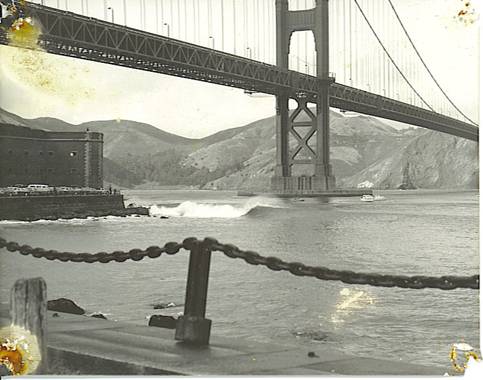 |
Jeff: I
developed this print of my beloved Ft. Point in my Dad’s closet
darkroom when I was 17, and it’s still pinned up in my garage to
this very day. Pushpin marks, age-yellowing and all, there are so many
good memories of this spot. When we
first began surfing here it was illegal and we ended up in the base
brig on a few occasions. I remember that I snapped this shot on our
first dawn trip there, and the truck hadn’t even stopped moving
yet, but I had to hang out the window to get this set as it poured
through… |
Photo
courtesy of Jeff Chamberlain.
It
seemed so much more wide open back then, but in reality, it’s
probably still plenty wide open even today, NorCal is kind of like
that…
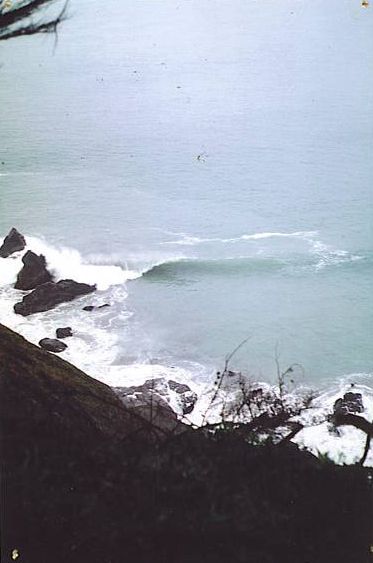
Photo
courtesy of Jeff Chamberlain.
I
spent decades in Big Sur, uncovering every nook and cranny… Kids
today want to grow up to be Kelly Slater or Dane Reynolds, Back then
the model was Wayne Lynch and Big Sur was my Australia.
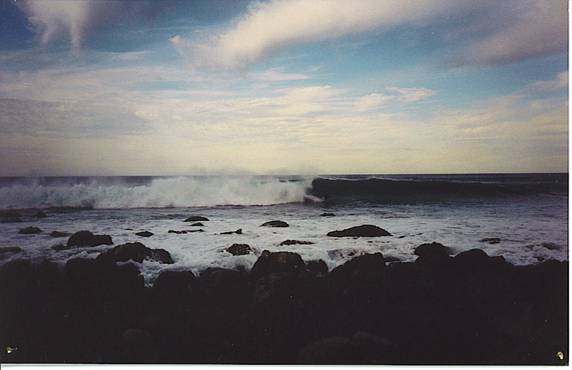
Photo
courtesy of Jeff Chamberlain.
On
a trip north, Russian Rivermouth offered up her gems.
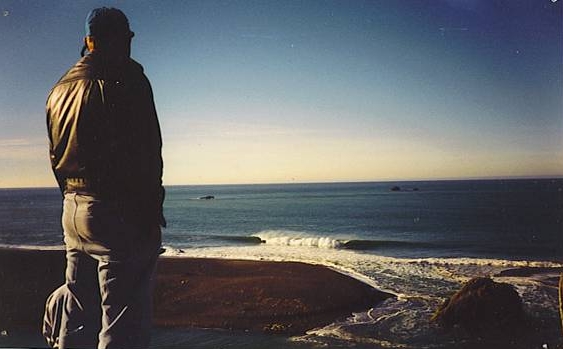
Photo
courtesy of Jeff Chamberlain.
2. I think you've been living
on the central coast since the 1970's... this is a notoriously fickle
surfing area. How did you end up here and how have the local waves and
conditions influenced your design and surfing approach?
Well,
college was the
draw originally. In 1973, when I first moved here, it seemed like a
true
surfing wilderness, and on many levels, it really was. Lots of room for
exploration, extremely low surfing populace, acres full of first
discoveries, and elbow room out to the horizon. Once I got down here, I
knew I would never leave, and lots of my friends from college ended up
staying as well and we all raised our families here. A friend once
described surfers as follows, "…you’re either a
guy who focuses on one specific break, and devotes his life to it, or
you’re a ‘free range surfer,’ constantly on the move,
grazing at will…", and that’s really the best
description of my surfing life: I love the free range aspect of surfing
around here. So many things change so rapidly here, but that was always
a good thing, and that aspect of it I think slowed the general
crowding; it’s just a very difficult area to figure out. This
County has so many subtle nuances that if you put in the work and
clock the miles you really have a leg up on the new groups of guys
working their way through their first decade here. If you really want
to surf alone, and have the personal commitment to make that happen,
this has always been the best place in California to live that kind of
life. For me, I couldn’t have lived out the bulk of my surfing
"career"’ in a place more perfectly suited for me and what
I’ve always wanted out of my surfing.
Along
the lower Sur, if you could figure out Mother Nature’s schedule,
and be there on the right tide, day, wind, angle, etc… the
payoffs were extreme.
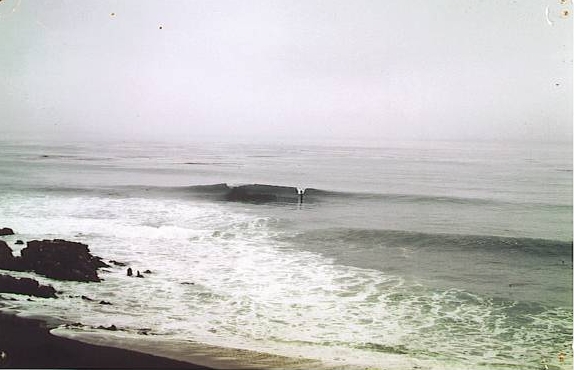
Photo
courtesy of Jeff Chamberlain.
The
Central Coast has always had it’s share of outer reefs. This was
one that both mystified and terrified, all at the same time.
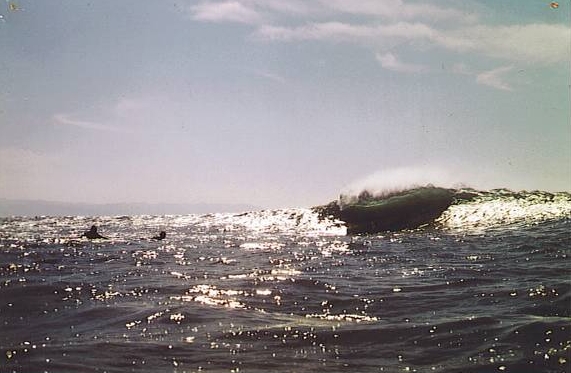
Photo
courtesy of Jeff Chamberlain.
On
an early trip to Tavarua I caught Restaurants with some size. I
did some foreign travel when I was young, Caribbean, Mexico, Costa
Rica, Fiji, and elsewhere. But my one true love has always been just
turning over every nook and cranny along my home stretch of coast, and
finding the purest of surfing realizations through that long
process…
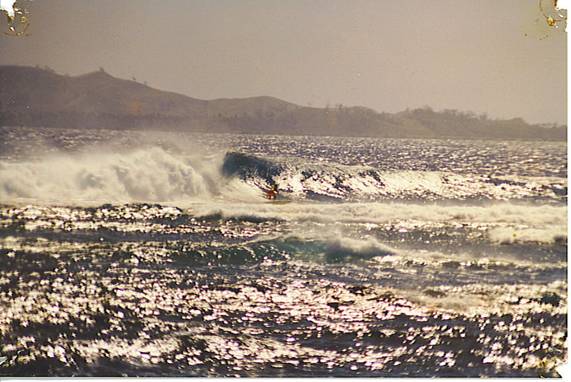
Photo
courtesy of Jeff Chamberlain.
3. Over the years you've had
various pieces published in different surf magazines about you and by you
(Surfer Magazine, The Surfer's Journal, Surfing Magazine, Pacific Longboarder (an Australian longboard
magazine), and some East Coast periodicals). The
most recent articles recount some of your journeys and surf trips on
your converted coastal fishing boat. What is the boat trip about, and
what kind of wave riding experiences open up for you because of it?
Well, I’m a journalism graduate from Cal Poly, so that’s probably where the
writing comes from. Two of my closest friends from high school were Sam
and Matt George, who both went on to very public surf journo careers,
so there’s always been that influence as well. I never went into
a formal career in journalism after college, but have contributed to
these various magazines (and some Patagonia catalog contract writing)
for over 30 years and maybe it was a way of showing my family that I
was putting that journalism training to some use… As well, when
I was in grammar school, my Dad always had a darkroom at the house, so
I’ve been a hobbyist photographer since when I was very young,
and it’s only accelerated as I’ve gotten older. I really
consider myself more a photo journalist as opposed to a pure "writer" type of thing, I’ll leave the Hemingway
aspirations to somebody else. It’s almost like I‘ve been
more like a war correspondent, but the front trenches for me have been
all the dawns at the bottom of slippery waterfall trail in Big Sur, or
tucked up inside a small cabin on a boat en route to some sort of
oceanic payoff zone. I’ve always heavily resented
California’s longtime infection with
localism… a large part of what I enjoy most
about surfing has always been the sharing aspect, and the writing
probably comes out of that on some level.
The boat thing? That’s really just a lifelong passion
that’s kind of dovetailed into my surfing. I was raised in a
boating family and did a lot of sailing and racing with my Dad when I
was young. I got my first boat when I was in fifth grade, a little El
Toro sailboat, and raced that till I gradually moved up in size as all
guys do. After college, with the surfing fixation in full flower, I
went through a series of inflatables and skiffs, all used primarily for
surfing at out of the way spots around here and elsewhere. If I still
lived up in the Bay Area I would have probably stuck with sailboats and
racing, but living here, it quickly metamorphosed into powerboats built
exclusively for hunting down isolated surfing venues. I was a Harbor
Patrol Officer for fifteen years, and the boat meter just kind of
pegged during all of that and has remained at that level since then.
The three Surfer's Journal articles on boats and surfing traced
the arc of my boat-lust progression, from exploring for surf using
kayaks towing surfboards, on through small custom boats and then
finally on to more mid-sized craft.
Up
off the Big Sur coast with some lifelong friends. We could carry enough
provisions to stay out for 3-5 days, and just reveled in the
experience.
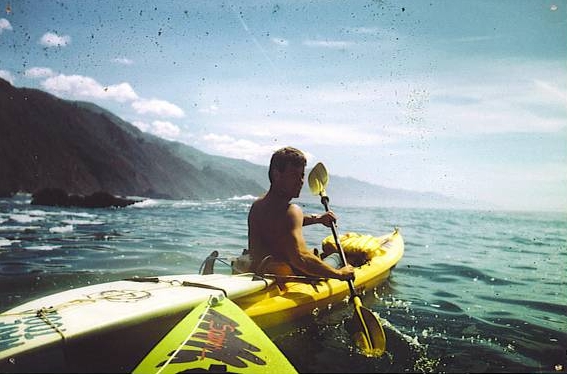
Photo
courtesy of Jeff Chamberlain.
We
used those kayaks to tow our various boards… and got into all
kinds of remote coastlines with them. Here, in a photo from a few
decades ago, we’ve made camp in a low slung arroyo up inside
Vandenberg Air Force Base... hiding out from Base
Security on a two-day mission further up the coast.
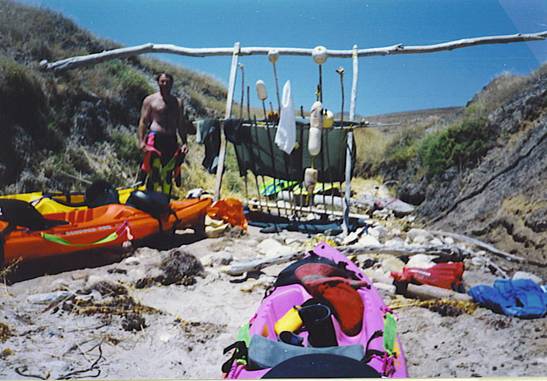
Photo
courtesy of Jeff Chamberlain.
Beach
‘em and go.
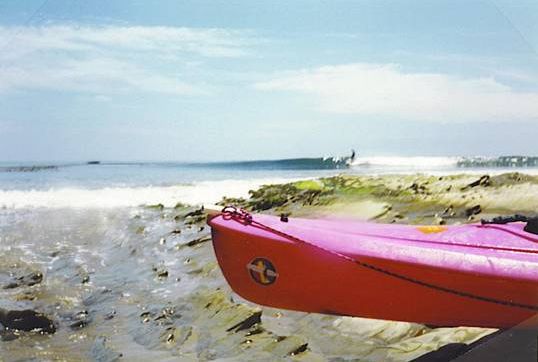
Photo
courtesy of Jeff Chamberlain.
Once
we built these homemade 10-foot surf skiffs, the explorations kicked
up a notch or two… They were small, but if used prudently, their
beach launchable size opened up a lot of venues for us.
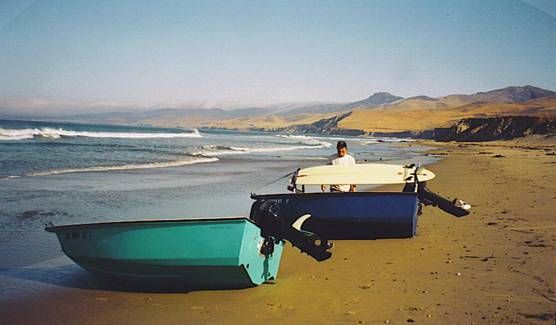
Photo
courtesy of Jeff Chamberlain.
Lots
to see and do.
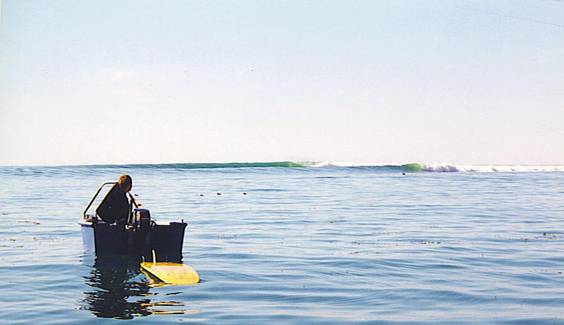
Photo
courtesy of Jeff Chamberlain.
Next
was a highly modified 15-foot Boston Whaler.
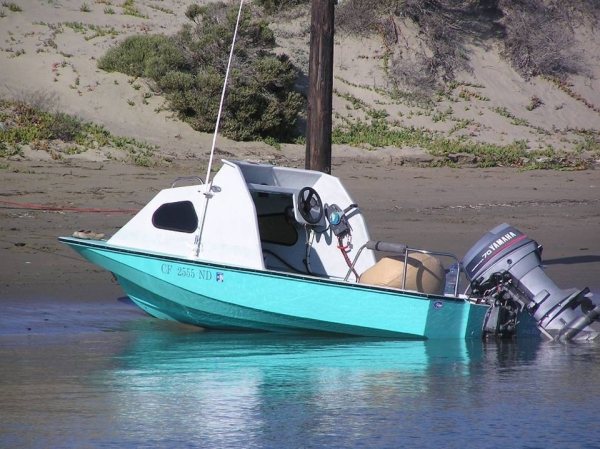
Photo
courtesy of Jeff Chamberlain.
But I’m still just a skiff pilot. I have no interest in "big" boats or
anything like that. In retirement, I’ve built a new 17-foot, twin-engine
Radon, and use it all the time for exploration and creating special
opportunities for my friends and I. I find that as I’ve gotten older,
I’ve become more particular about the types of waves that I want to
engage in. And, it’s these same types and venues for waves that the
prone approach seems to best fit in, so I use the boat to connect the
two. I trailered it up to Vancouver Island this past summer for a month
on the hunt, and that was an incredible experience, just living out of
the boat and blasting around up through the fjords to the coastal zones
that we felt would provide good exploration. I’ve done boat-surf trips
there now a total of three times, and it’s as viable a surf hunting
venue as any I’ve come across... I’ve still always got a camera with me
wherever I go, so the articles always just grow out of this personal
recordation process (now digital) that I’m always going through.
I
bought the Radon hull from a farm way out off the beaten track in the
wilds of Northern California. It had been an old commercial urchin
diving boat, and underneath the peeling paint and crust, I could tell I
was onto something…
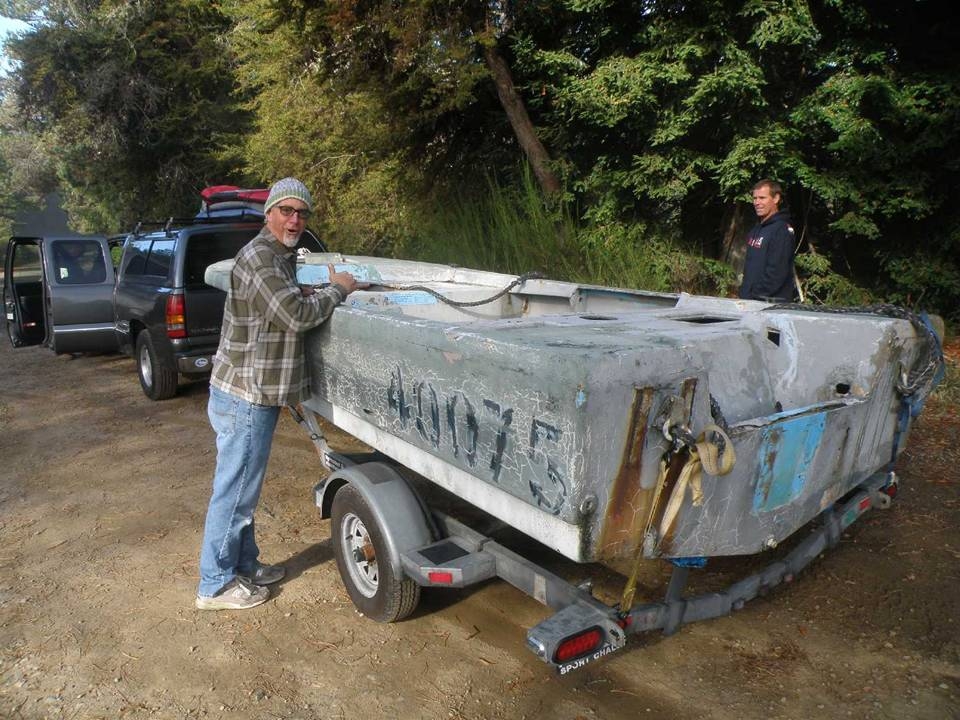
Photo
courtesy of Jeff Chamberlain.
Down
at Anderson Custom Boats in Goleta, we gutted it back to a bare hull,
stretched the length 12.5”, and began the re-build.
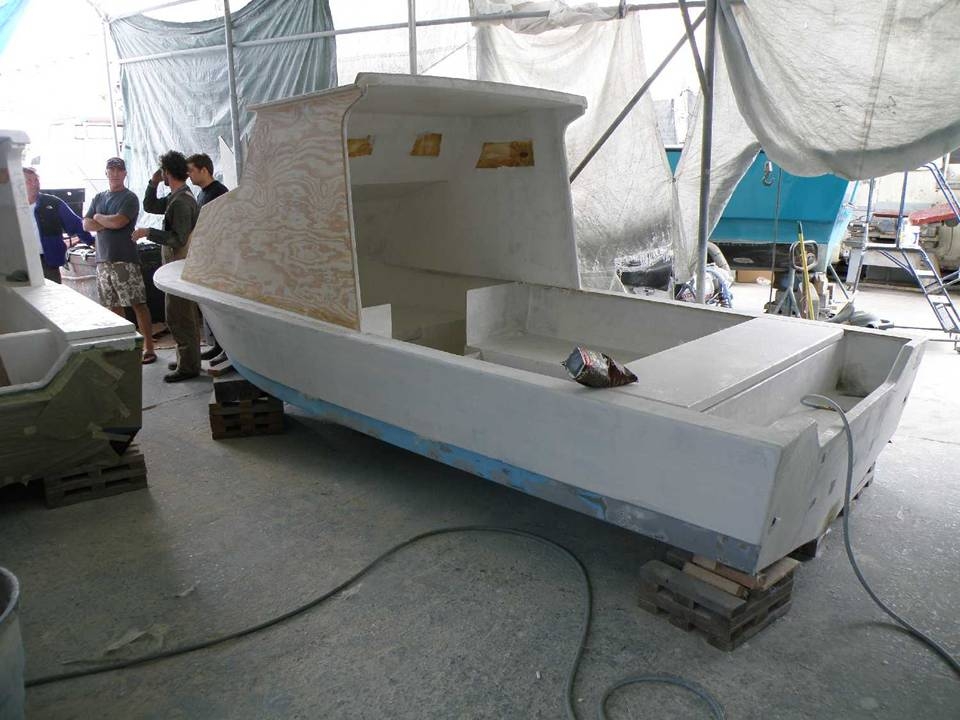
Photo
courtesy of Jeff Chamberlain.
It’s
not the goal but rather the trail that is important…
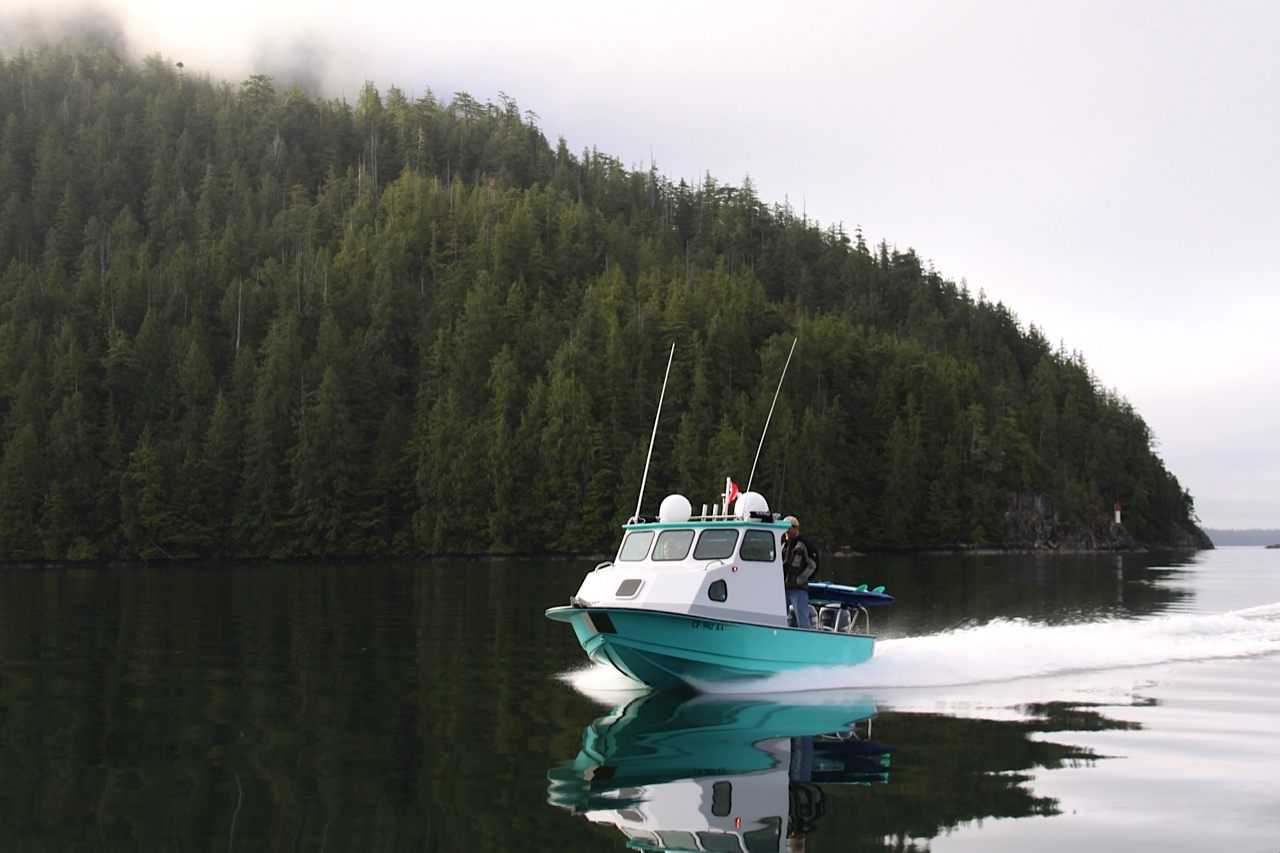
Photo courtesy of Jeff Chamberlain.
Chamberlain, Jeff. (1994, Summer). No Option Left Unexplored. The Surfer’s Journal, 3(2), 28-37.
|
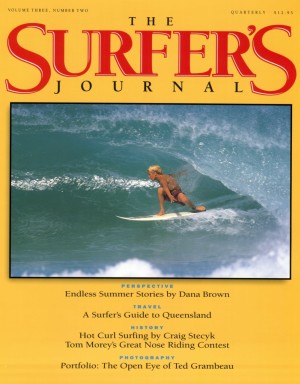
|
|
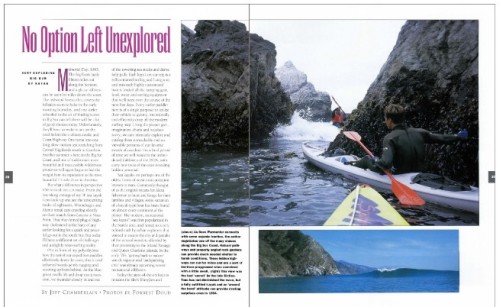
|
Photo
courtesy of Jeff Chamberlain.
Chamberlain, Jeff. (2000, Summer). And A Tiller To Steer By. The Surfer’s Journal, 9(2), 100-119.
|
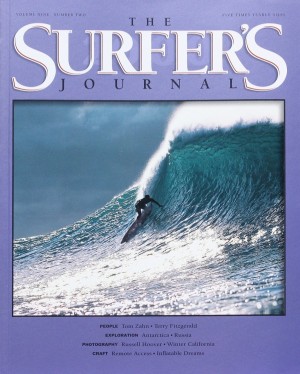
|
|
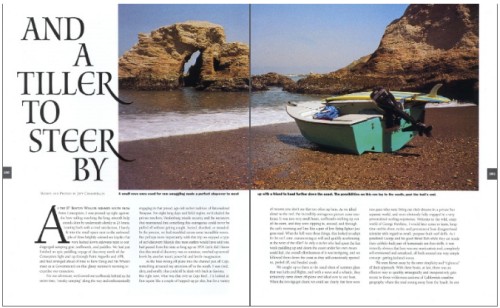
|
Photo
courtesy of Jeff Chamberlain.
Chamberlain, Jeff. (2005, Fall). Up On Plane. The Surfer’s Journal, 14(5), 38-47.
|
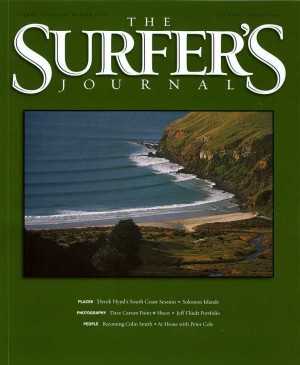
|
|
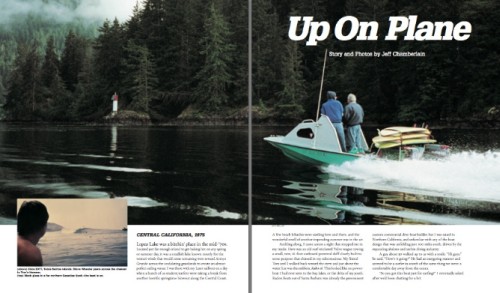
|
Photo
courtesy of Jeff Chamberlain.
Of all the stuff I’ve had printed over the years, I’m
probably most proud of The Surfer's Journal pieces. It’s the only
"series of three" inter-connected articles that the Journal
has ever run, but I think the exploration mojo strikes a chord with
their readership.
But I’m still just a skiff pilot. I have no interest in "big" boats or anything like that. In retirement,
I’ve built a new 17-foot, twin-engine Radon, and use it all the
time for exploration and creating special opportunities for my friends
and I. I find that as I’ve gotten older, I’ve become more
particular about the types of waves that I want to engage in. And,
it’s these same types and venues for waves that the prone
approach seems to best fit in, so I use the boat to connect the two. I
trailered it up to Vancouver Island this past summer for a month on the
hunt, and that was an incredible experience, just living out of the
boat and blasting around up through the fjords to the coastal zones
that we felt would provide good exploration. I’ve done boat-surf
trips there now a total of three times, and it’s as viable a surf
hunting venue as any I’ve come across... I’ve still always
got a camera with me wherever I go, so the articles always just grow
out of this personal recordation process (now digital) that I’m
always going through.
Up
along the west coast of Vancouver Island, 7am on a Tuesday in July.
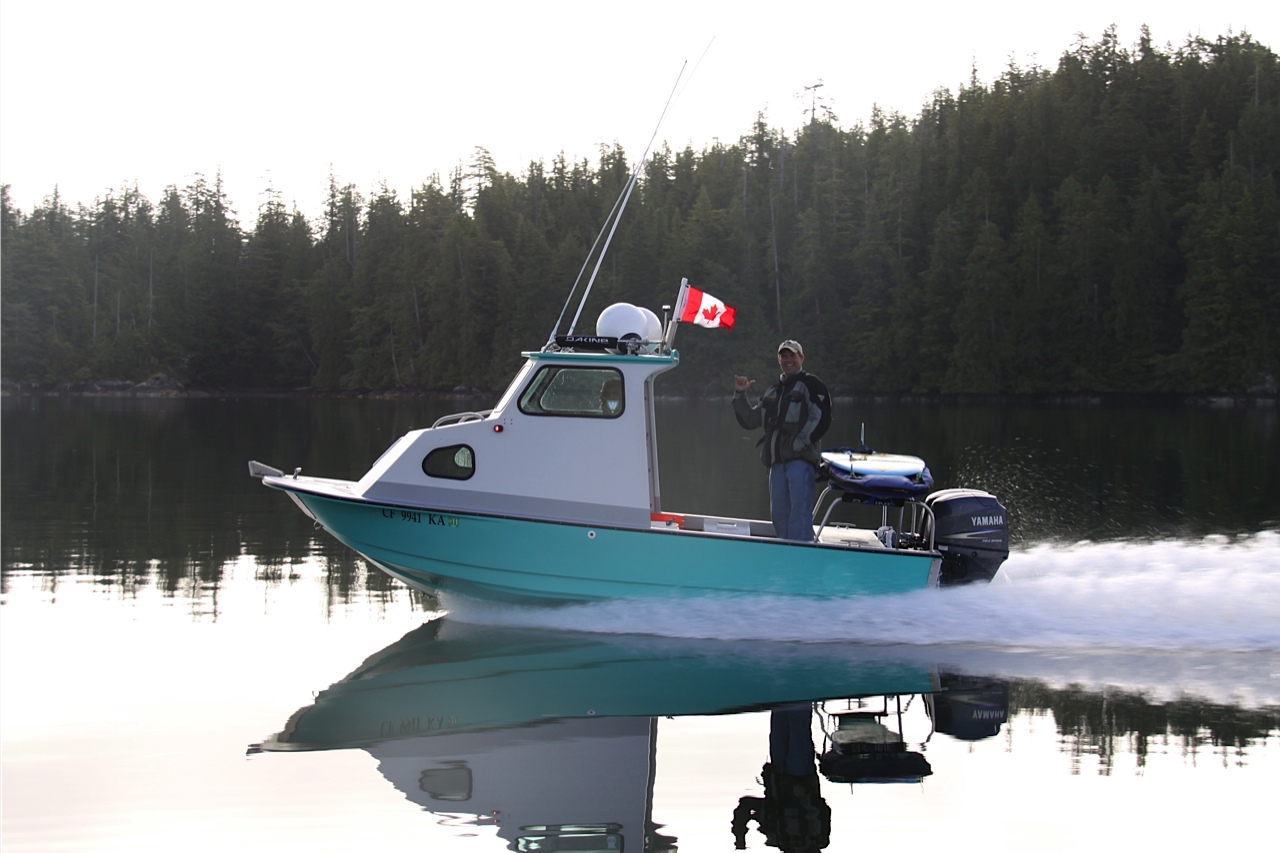
Photo
courtesy of Jeff Chamberlain.
Seek
and ye shall find.
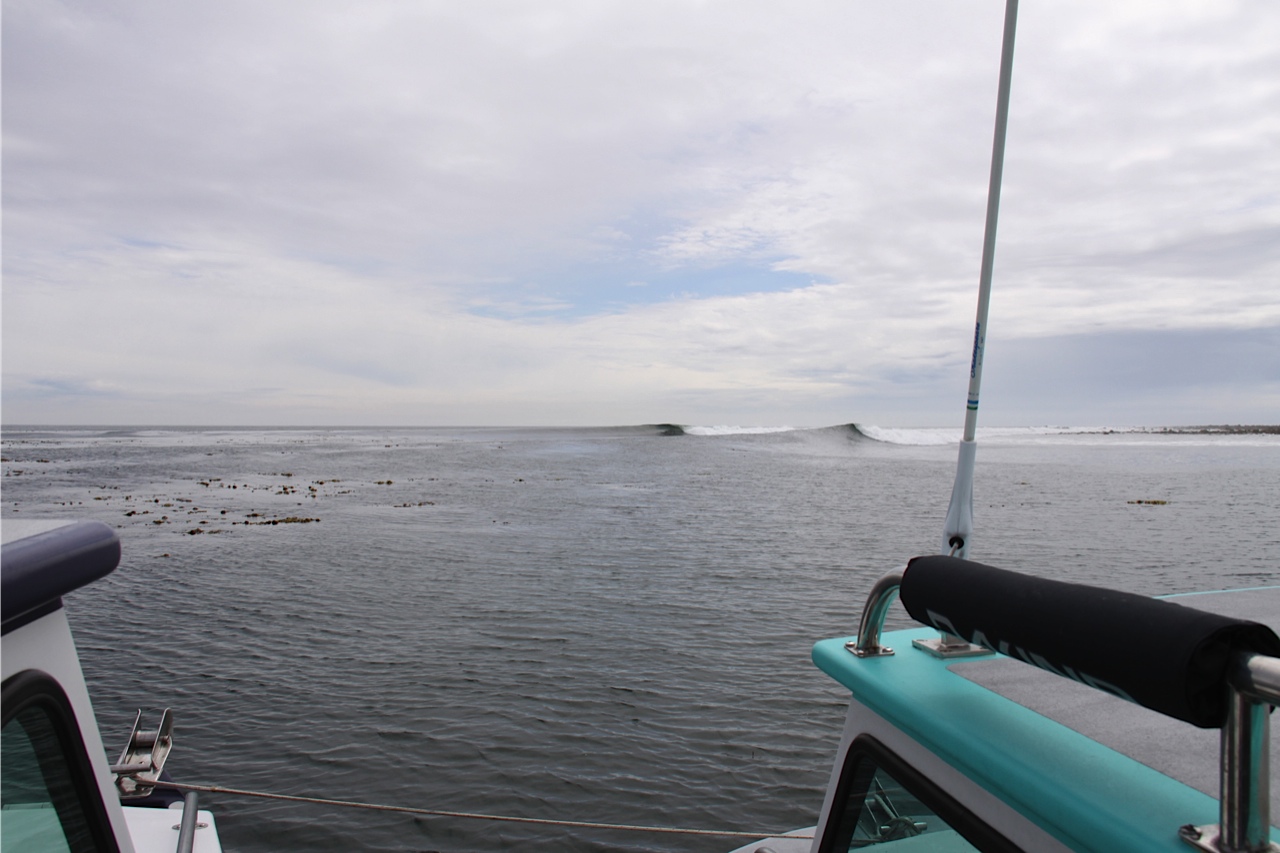
Photo
courtesy of Jeff Chamberlain.
Small
fishing village stop in a protected nook along the outer coast for a
cup of coffee and a slice of pie.
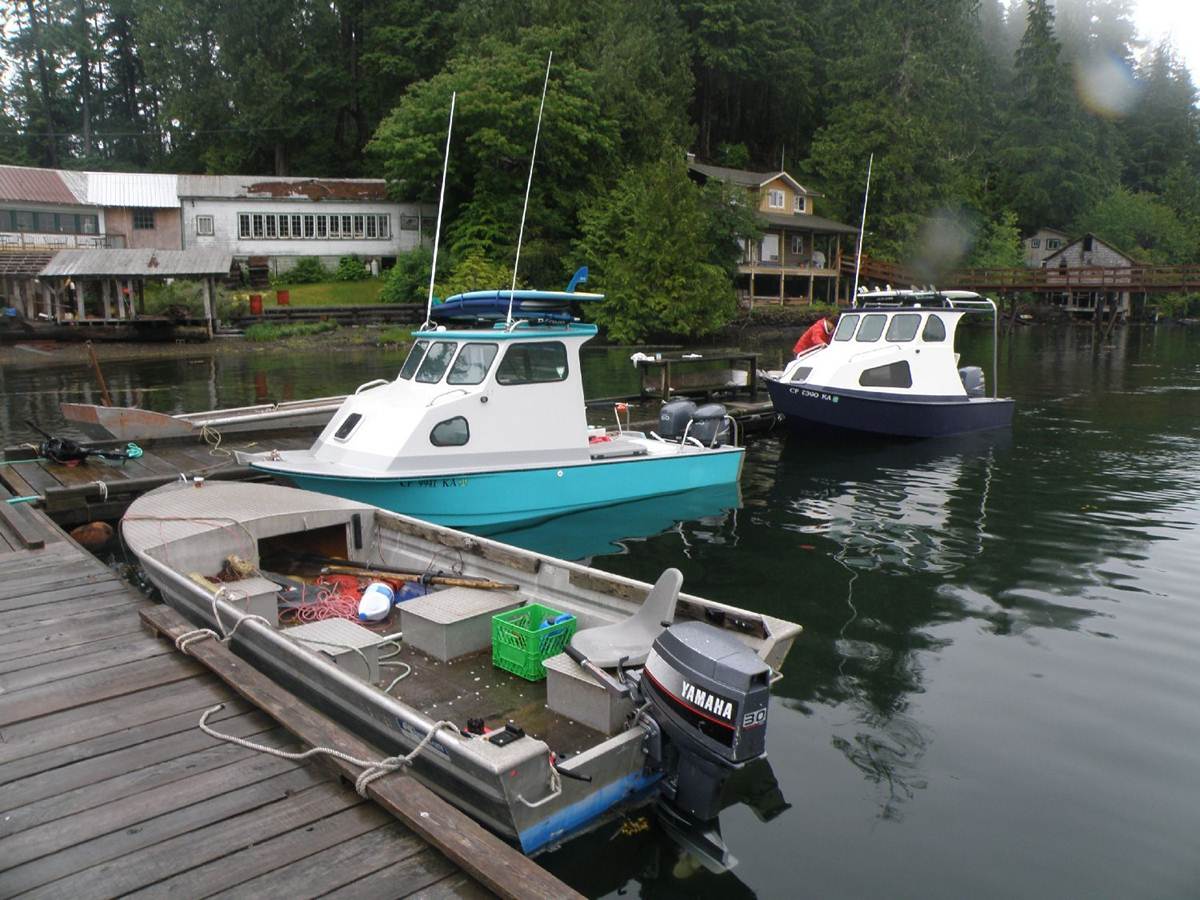
Photo
courtesy of Jeff Chamberlain.
4. So how and why did you get interested in riding
paipos? What were your first boards like.. anybody else doing it..
and what were you looking for?
Well, like I
mentioned, my first "board" was a homemade paipo, so I
really kind of started from that place? And that seems to be typical,
most of my buddies all started on these things. In my adult life,
I always had a few custom bellyboards in my quiver -- in the beginning,
shaped by my friend, Dave Parmenter.
One
of my earliest DP’s, a 5’ x 22” twinnie.
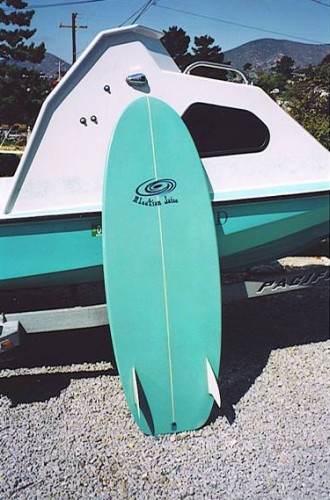
Photo
courtesy of Jeff Chamberlain.
It
worked well, but left me feeling at the end of things that there was
still some hidden truths to be pried out of the next set of
blanks…
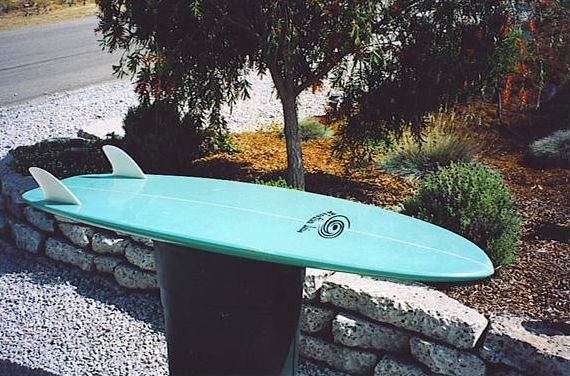
Photo
courtesy of Jeff Chamberlain.
With
that in mind, before leaving Vancouver Island, I gave my Parmenter
prone device to our Canadian bush guide as a gift…. It rode
around to lots of good surf for a few years on top of this local boat
and saws lots of isolated points and reefs. It gave me a little smile
knowing that this board was living out it’s retirement, way up
north, on it’s own separate adventure, far from where it was
envisioned and created.
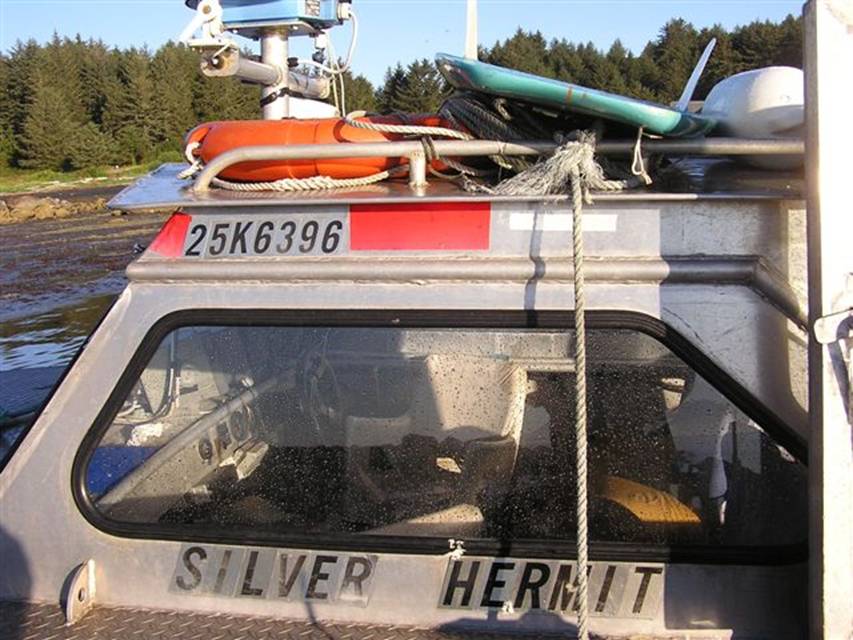
Photo
courtesy of Jeff Chamberlain.
But these early designs...I only used them
on occasion, maybe 2 or 3 times a year, at very specific breaks, at
very specific times. Both of my feet were still firmly planted in the
longboard camp… About four years ago, I sustained a shoulder
injury that ended up leading to surgery, and during the post-op rehab,
once I was OK’d to return to surfing for the health benefits, I
decided to re-enter surfing slowly, using the bellyboard or paipo deal
to get back in the water. But before I jumped in, I determined that I
wanted to experiment with some larger, more extreme templates that
I’d been thinking about, and figured this might be the opportune
time. As I began to explore that realm, the light clicked ON as they
say, and after that, I was having so much fun running down this new
path at full speed that I completely gave up the concept of ever going
back to what some folks might call "regular surfing."
5. At some point, it sounds
like paipo became your exclusive surf vehicle of choice. When and why
did that happen? How has that affected your surfing life and stoke?
For me, the decision
to go deeper into the paipo experience as opposed to getting back on
some generic longboard just seemed beyond logical. In every way, I find
the prone surfing thing superior. Instead of cruising along with your
head six feet above the wave, trying to stylistically replicate some
culturally accepted and rigidly mandated pose from 1963, I’m now
right back IN the pocket, and who doesn’t prefer that view? I get
more tube rides in one day than I used to get in a year, and the
sensation of speed while doing all of this is way more extreme. It
feels like far better whole-body exercise, and it makes me feel like
I’m 12-years-old again and who can’t get behind that?
Beyond the actual surfing part of it, I love the whole board design
exploration aspect that comes part and parcel with the prone surfing.
Very few people, as you know, are out there actively exploring down
this avenue, and I’ve always been a board design guy, getting
custom boards since high school and never looking back. I don’t
think I’ve had an off the rack board in over 40 years. So for me,
the designing of these new boards and the experimentational aspect of
this whole process is a big part of my attraction to it; I love the
whole self-analysis of trying to figure out the "what" and "why" of what it takes to make these boards work for me at
where I like to surf.
As I look around the great wide surfing landscape, I notice that all of
my buddies seem to be going SUP these days, and though I’m not a
hater, it’s not the direction I want to take my surfing. I "get" that they dig the SUP for it’s "newness," the very real freshness of it. After surfing for
over four decades, who wouldn’t admit to a bit of "staleness" if you’re still doing the same freaking
thing you’ve been doing for decade after decade? But, I’m
going the opposite direction with it -- I’m off on my own personal
version of the shortboard revolution. Shorter, tighter, more in the
pocket, it’s just been a fantastic change for me and it’s
only getting better. I look at longboard surfing now and it feels so
much more "removed," so restrictive and quite apart from
what I’m trying to do. I couldn’t ever imagine ever going
back.
These
shots are from a day on my latest 6’3” x 29” single
fin. With a little oceanic cooperation the results can be illuminating.
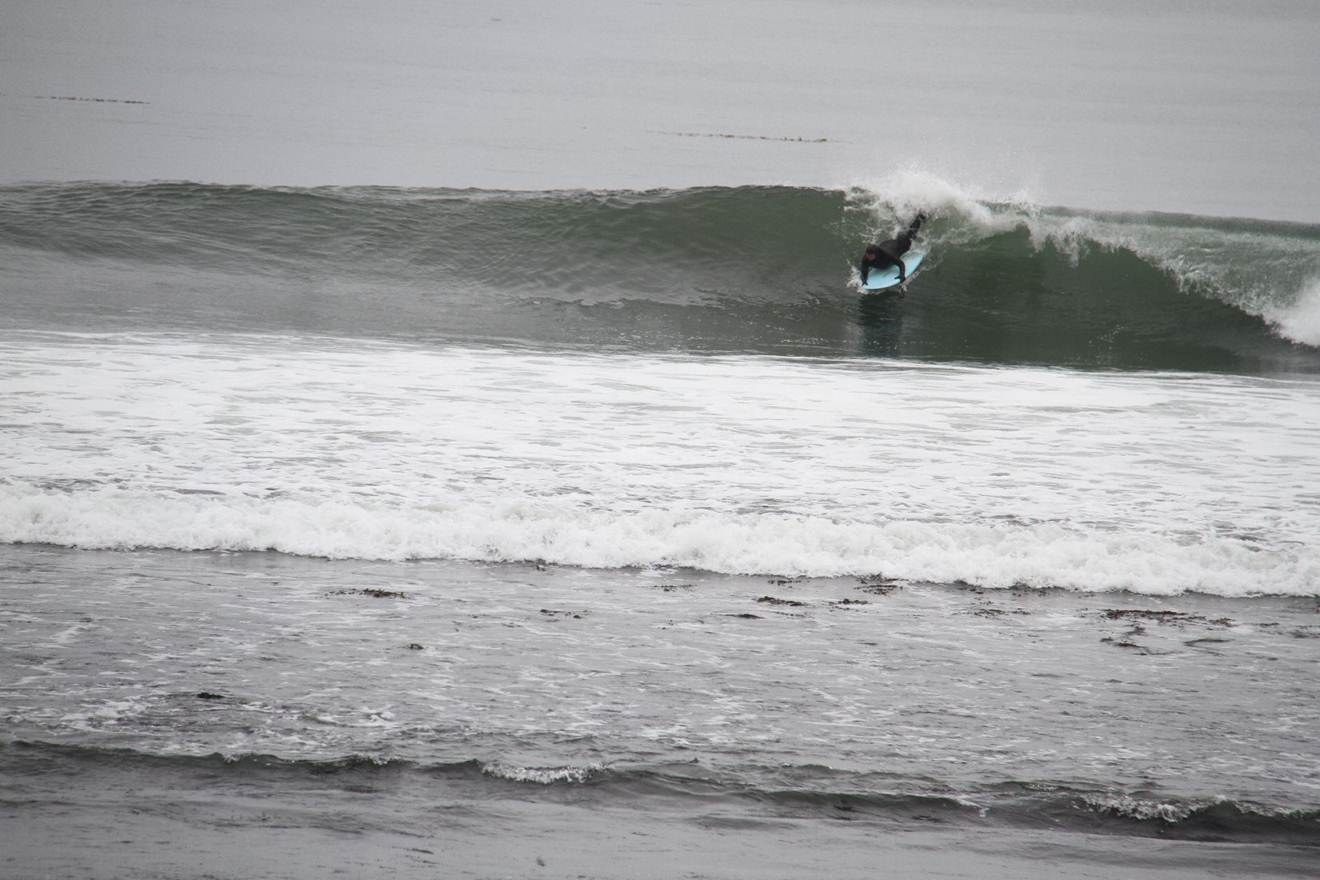
Photo
courtesy of Jeff Chamberlain.
One
aspect of these wider templates is the very real speed that can be
generated on any sort of turn. The extra width seems like simple
additional horsepower -- it is something that I didn’t feel with
my smaller boards.
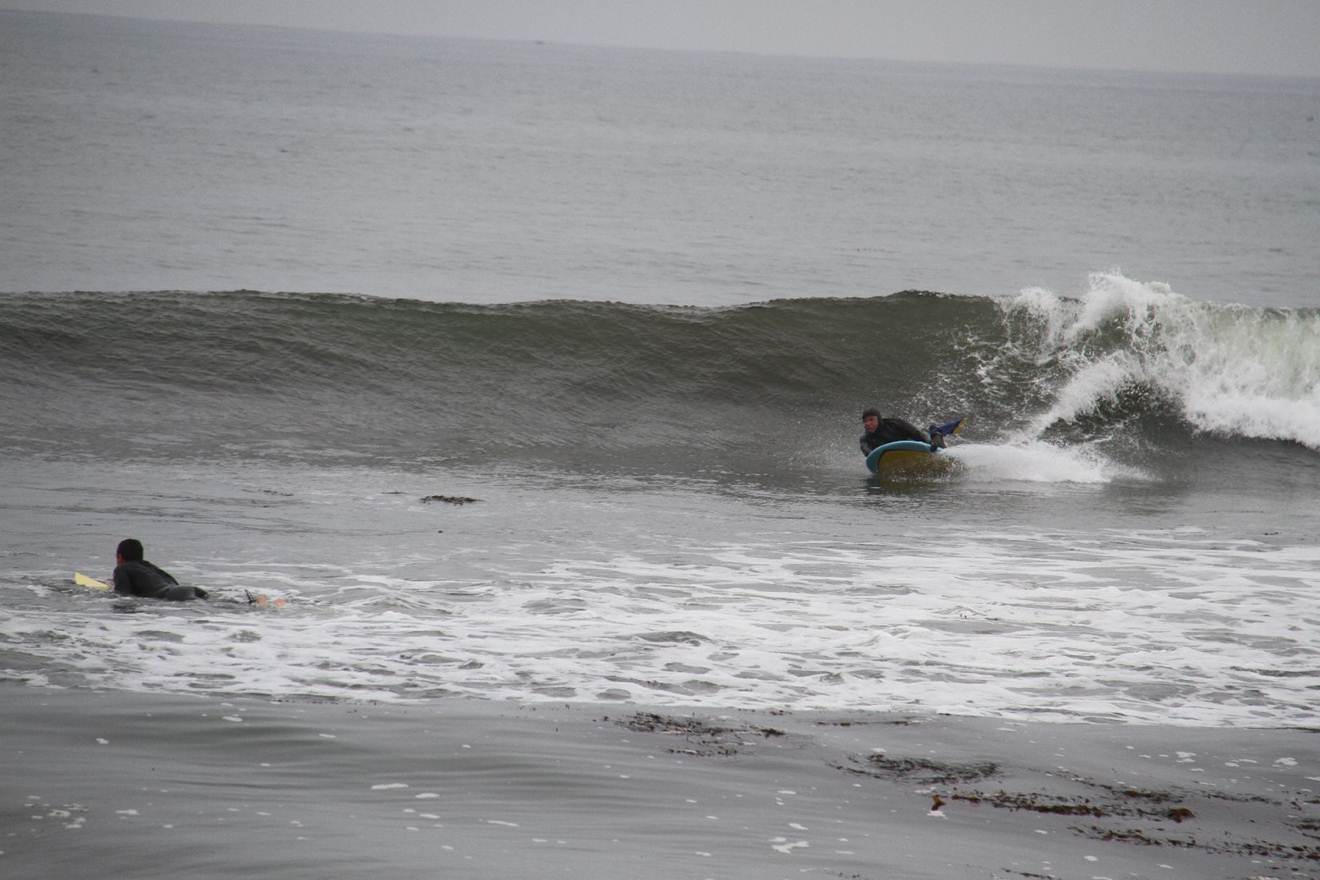
Photo
courtesy of Jeff Chamberlain.
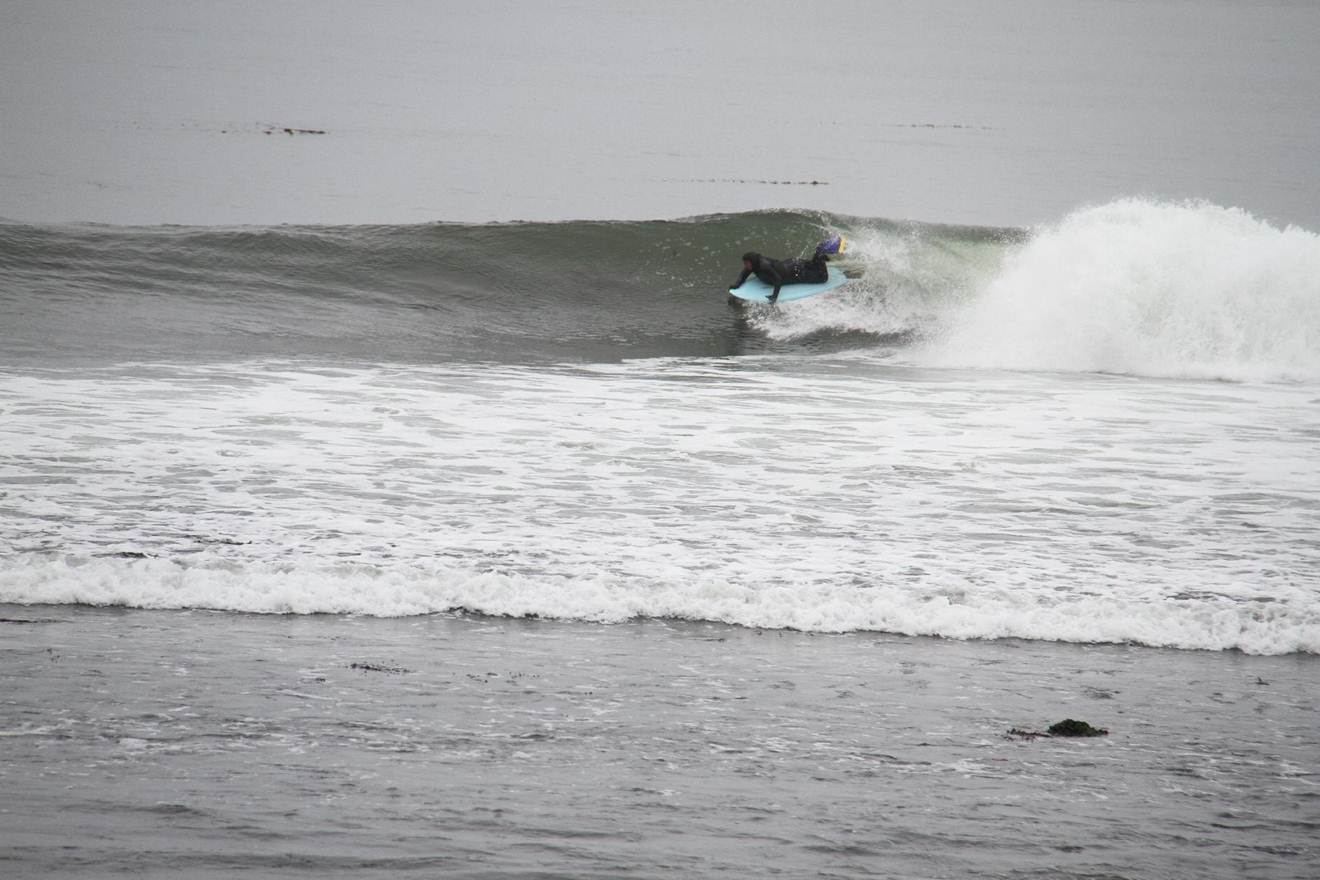
Photo
courtesy of Jeff Chamberlain.
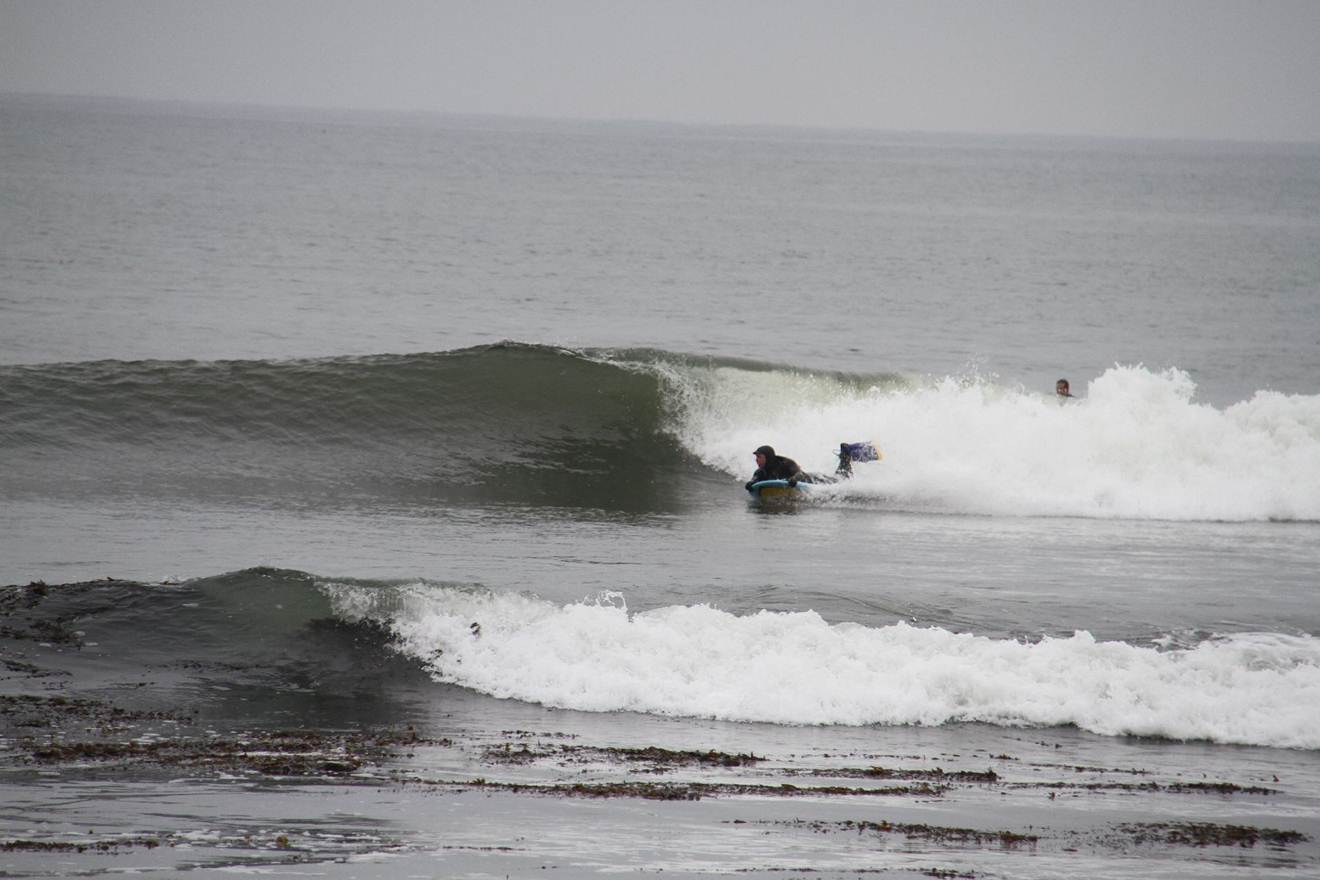
Photo
courtesy of Jeff Chamberlain.
It’s all one big experiment.
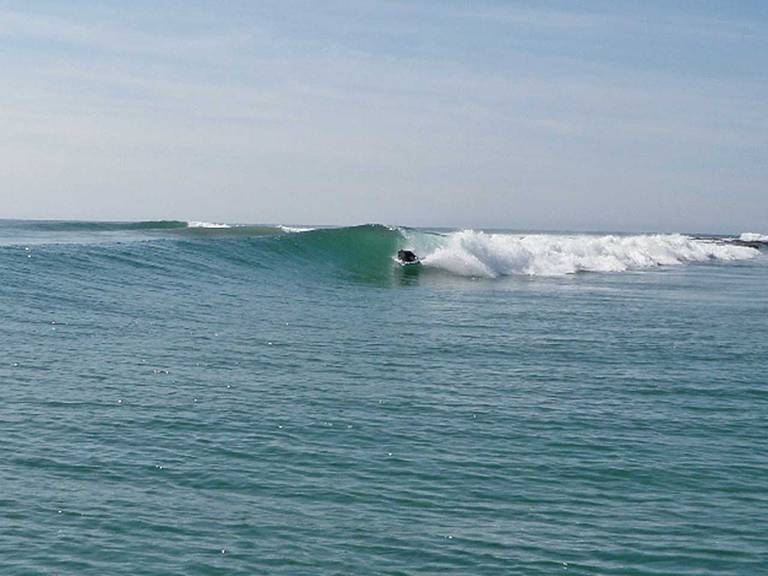
Photo
courtesy of Jeff Chamberlain.
Two paipo nui’s floating alongside and waiting their turn…
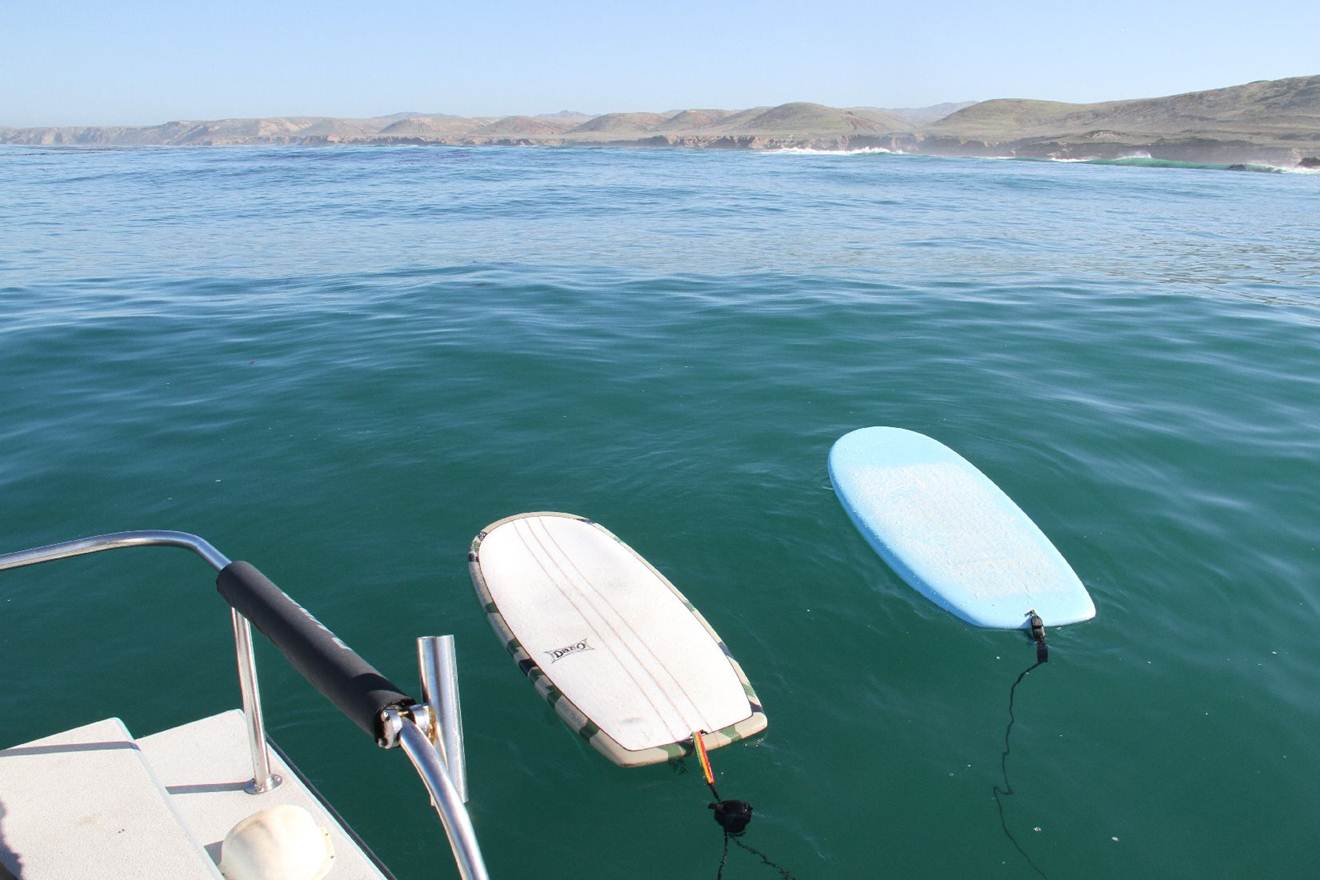
Photo
courtesy of Jeff Chamberlain.
Heading
back out after lunch
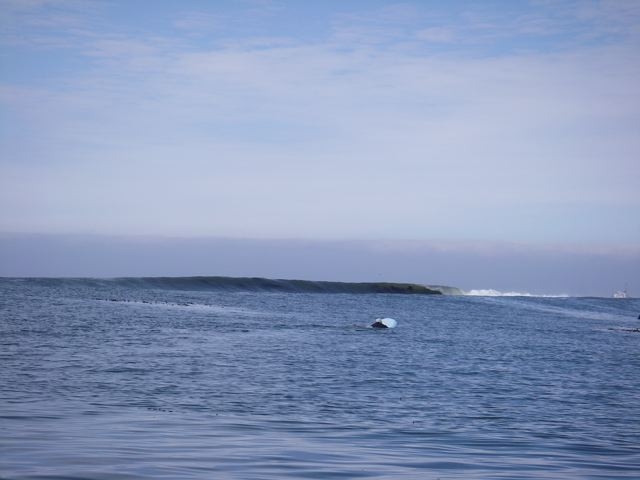
Photo
courtesy of Jeff Chamberlain.
6. You've recently been
experimenting with some wildly different paipo designs... most noticeably
with a relatively extreme template, width and length, compared to most
other paipos currently out there. Talk about those boards... what was the
inspiration, what were you looking to achieve, who helped you out, and
what are the results so far?
For me, these new boards have been the whole key. My oldest bellyboards
were always more "standard’ sized," meaning they were just
extensions of what I’d had as a kid. But somewhere along the
line, I began to sense that if I enlarged the templates, I might see
immediate benefits. I always loved the more round-nosed "slab" templates of Aussie kneelo Peter Crawford, so that
aesthetic has always been incorporated into my designs. A buddy of mine
had been friends with George Greenough and he had taken a paper
template off of George’s infamous ‘Velo.’ We used
that at first to create my initial series of what I called my "5
x 2’s," meaning they were 5-foot long and 2-foot, or
24 inches wide. I began to surf those and saw an immediate elevation of
what I could do, and that was when the revelation hit. From there, I
began to modulate the templates and went to a series of
5’6” x 26’ boards, and BAM, more performance
improvements. I was beginning to think I was onto something…
An early EPS flyer, 5’ x 24”, one of the first of a series
of ‘five by twos.’ With this board I began to try and
incorporate more of the Peter Crawford "slab,"
round nose template, which provided immediate benefits when
tested.
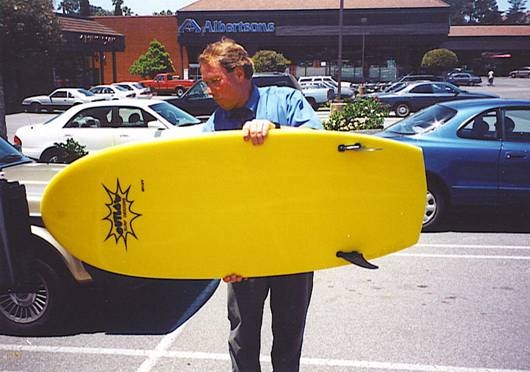
Photo
courtesy of Jeff Chamberlain.
I’m now at 6’3” by 29”, and I think I’m
at the perfect dims. But to get here, I had to take my inspiration from
the experimental world of the modern SUP. Once the SUP vanguard showed
the surfing culture how idiotic it was to restrict board width to what
had been the culturally accepted limit of 22 to 23 inches, the doors just
blew open. Now, guys are ripping on these SUPs at Pipeline, and
on boards with 35” (and beyond) widths. Mind blowing. For me, the
historical trail of board design is a series of slow mental
breakthroughs, all having to do with various sizes and shapes, and what
was, at that time, the mental restriction and limitation to those
dimensions as the "final, best thing." Very slowly, surfing
as a whole has broken through those barriers and often hyper-jumped to
the next level. SUPs kind of drop-kicked the surfing culture
into larger templates and dimensions It was in studying some of
these designs that I thought maybe some of that could be borrowed and
brought over to my own personal version of the paipo or prone surfing
thing.
A friend paddles out along the Canadian coast, south swell, mid tide.
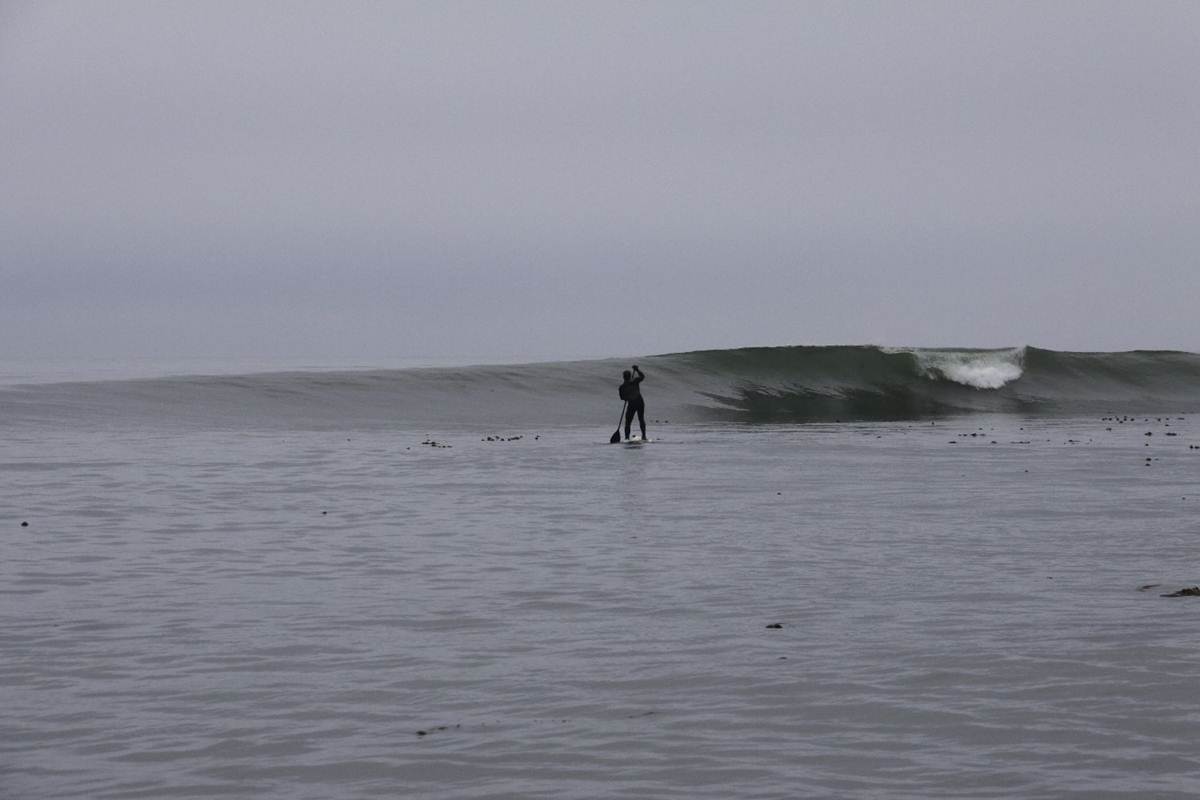
Photo
courtesy of Jeff Chamberlain.
I took that new concept of extreme width and applied it to the paipo board, and
to me, the results have been self-evident. The extra width generates
tons of new horsepower, and it’s been the key to elevated modes
of speed and maneuverability. I know that for a lot of paipo riders,
they’re going down the more historic path of riding boards that
are creating for them a type of almost "bodysurfing
experience." And I’m totally supportive of that, and dig
watching it whenever I can. But for me, I was always more about
re-creating some type of "board riding" experience, and the
bigger boards for me get me to this place more effectively.
An
early 6’3” x 29” twinnie. The blanks are regular
"fish blanks" from U.S. Blanks, but with "spacers" inserted into the
blank alongside the stringer to
allow for the extra width to be shaped in.
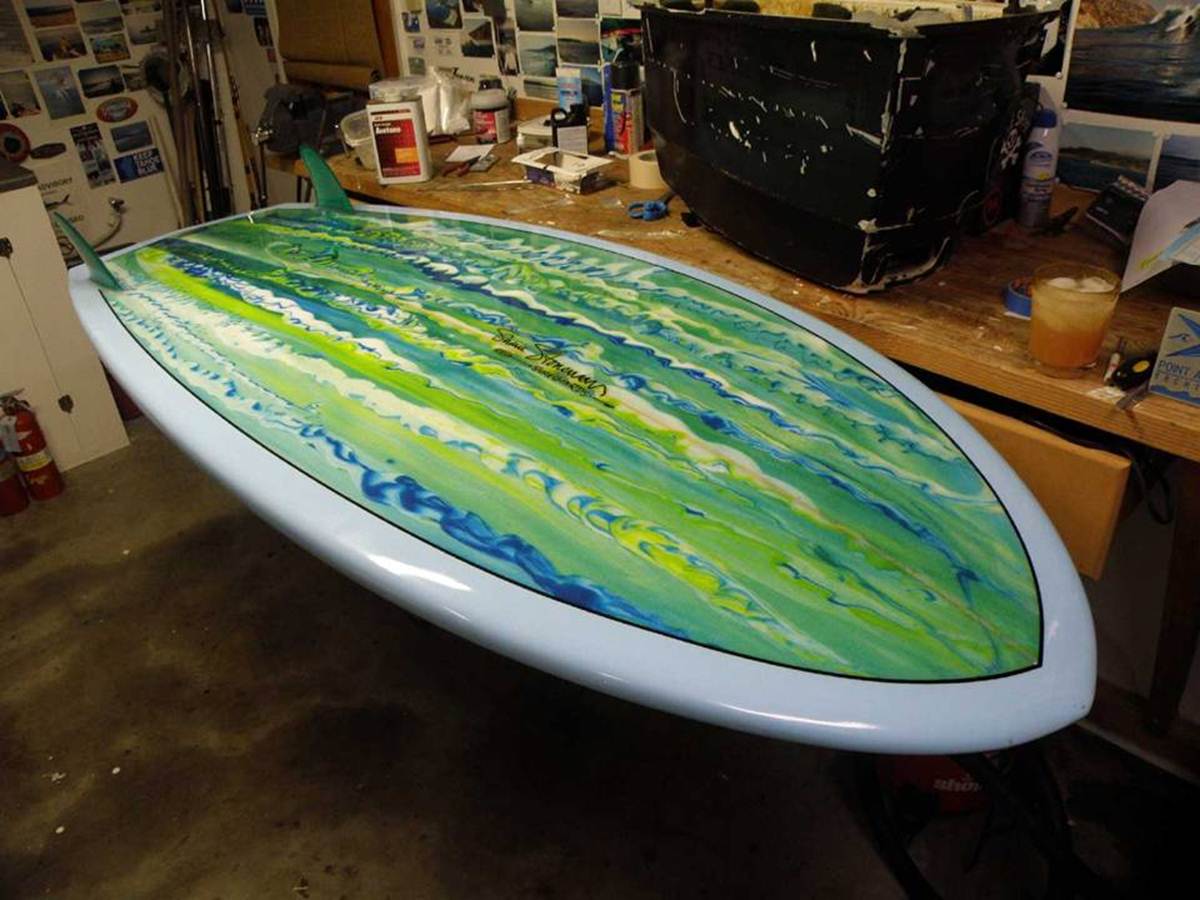
Photo
courtesy of Jeff Chamberlain.
Shane
Stoneman, here in Los Osos, has built me some absolutely beautiful prone
boards, this one here having been nicknamed "The Big Blue Blob Of
Happiness."
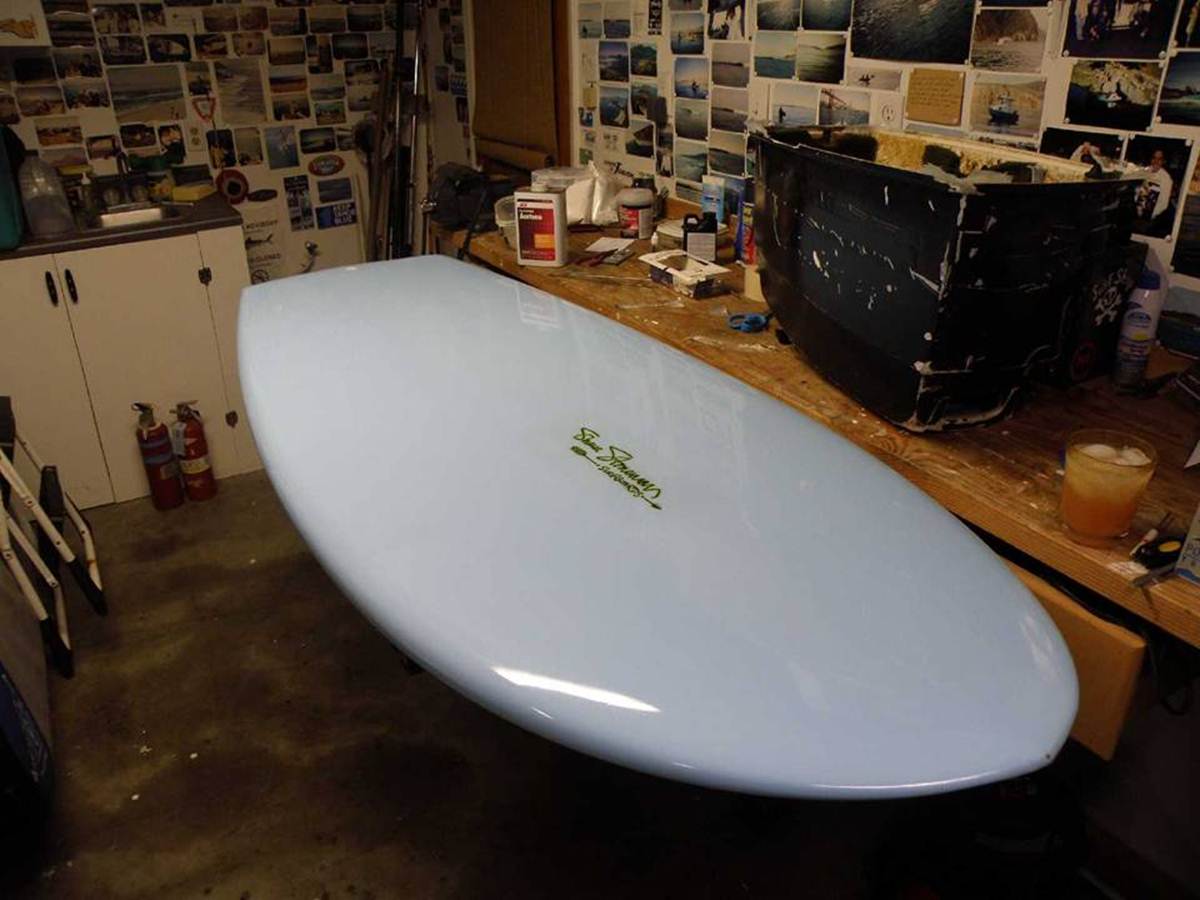
Photo
courtesy of Jeff Chamberlain.
Lying
on a remote west coast Vancouver Island beach this board waits for
7 feet of tide to sweep in and metamorphose the break out in front.
The board was shaped by a longtime shaper of mine, John Mellor, and we
went with a single concave under the rear third of the
board. The forward third is more like a Liddle hull with
a demonstrably rolled belly. It seems slower than my flatter twinnie,
but seems to fit in the pocket better, and I love the way the board
rolls up onto a rail while turning.
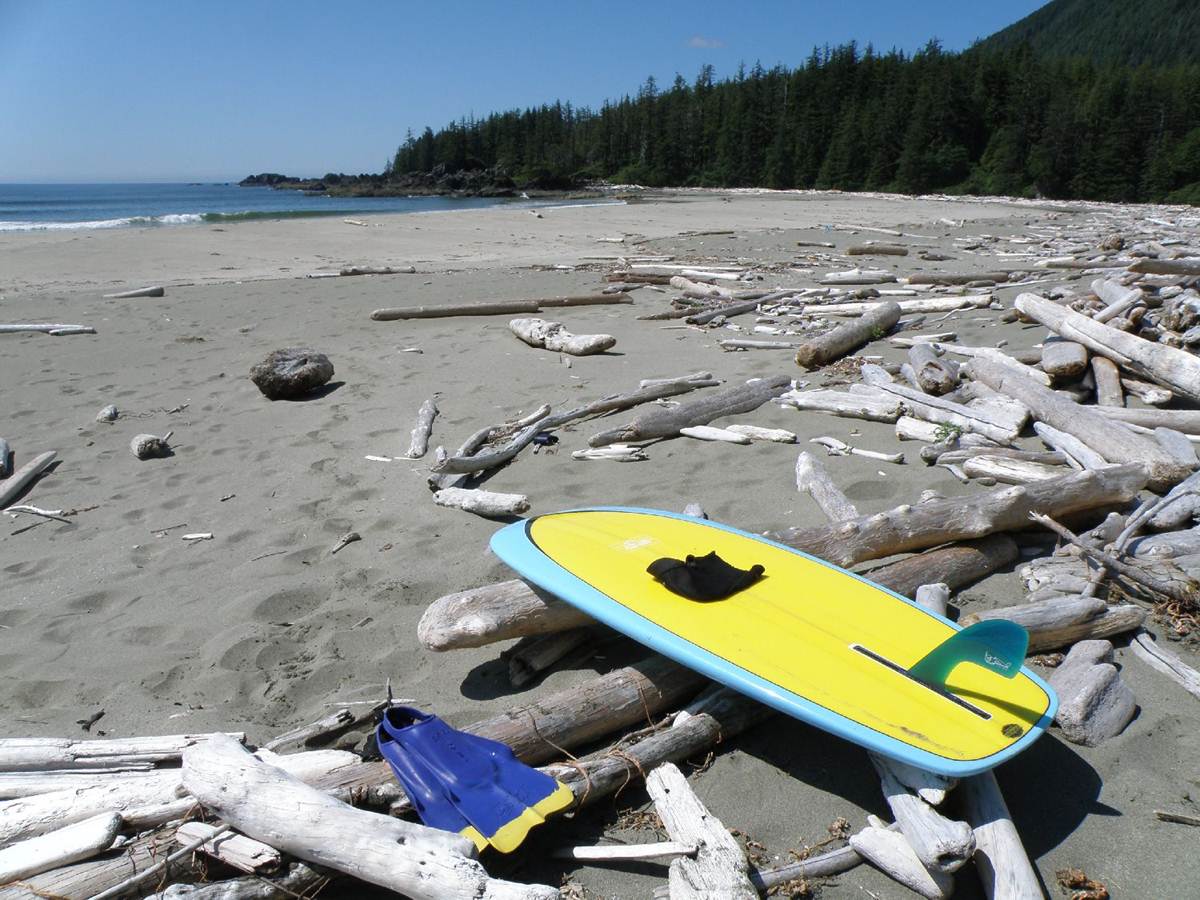
Photo
courtesy of Jeff Chamberlain.
Vancouver
Island section…
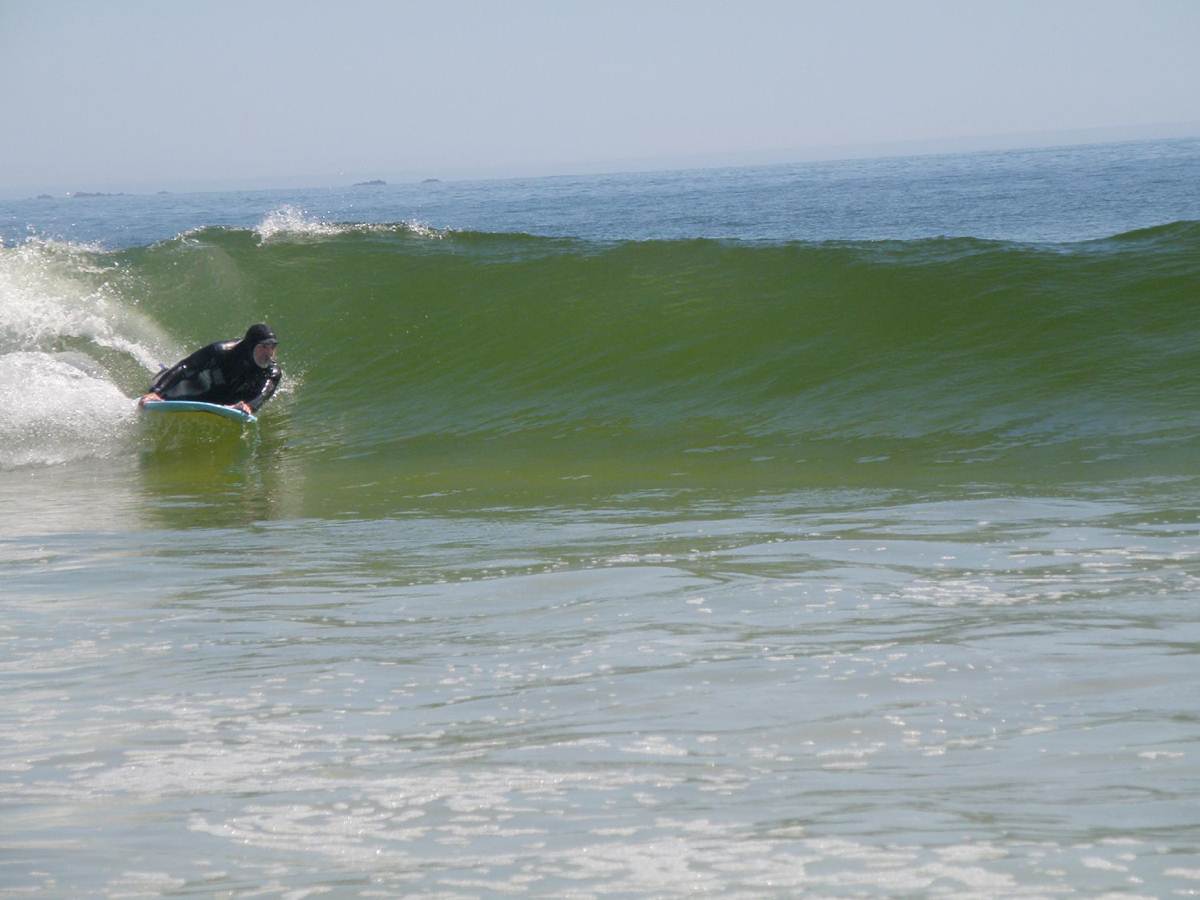
Photo
courtesy of Jeff Chamberlain.
My buddy, Brad, borrowing the board for some prone-time edumacation. He
commented on the instantaneous speed generation and ease of catching
waves; again, I believe mostly due to the extreme width… [See Note 1.]
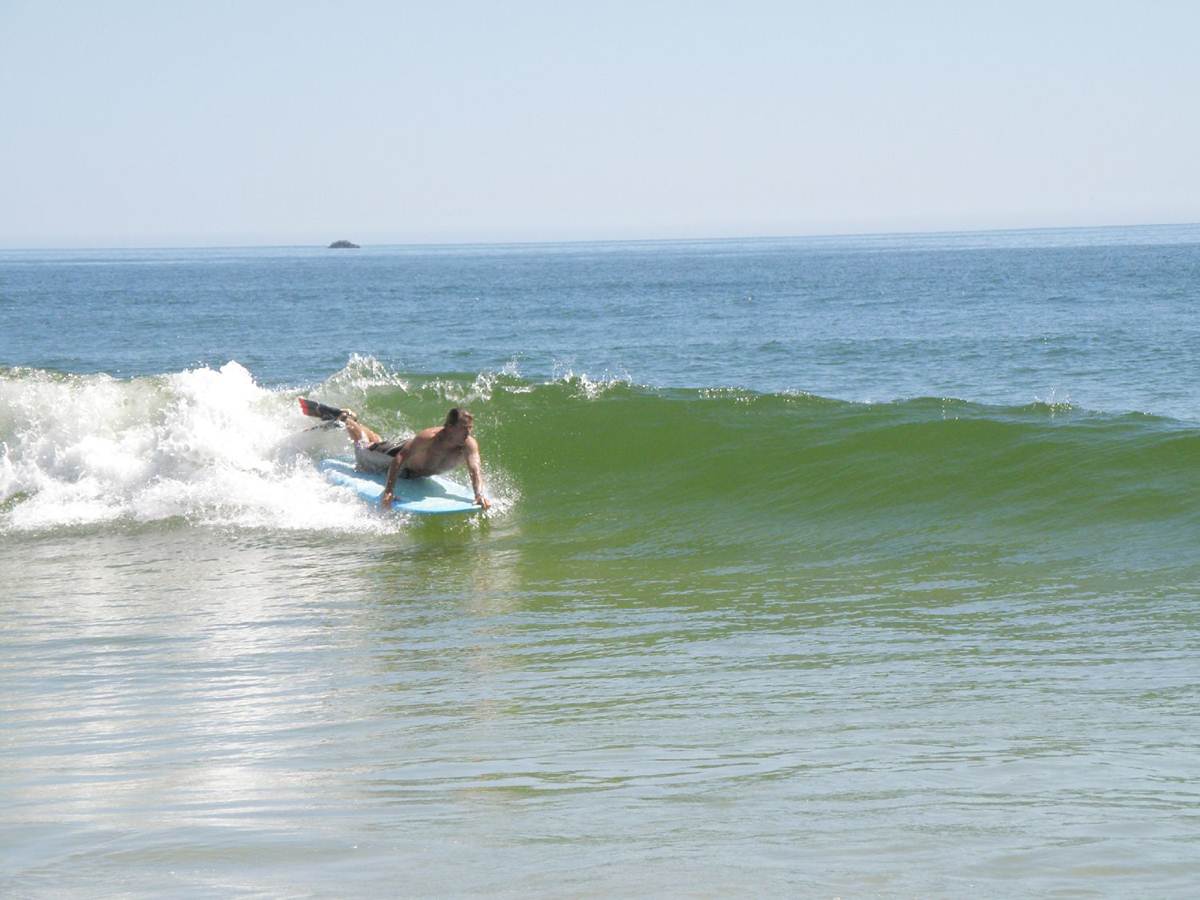
Photo
courtesy of Jeff Chamberlain.
Poking
around first thing in the morning, running up the coast to a break
we’d heard about….
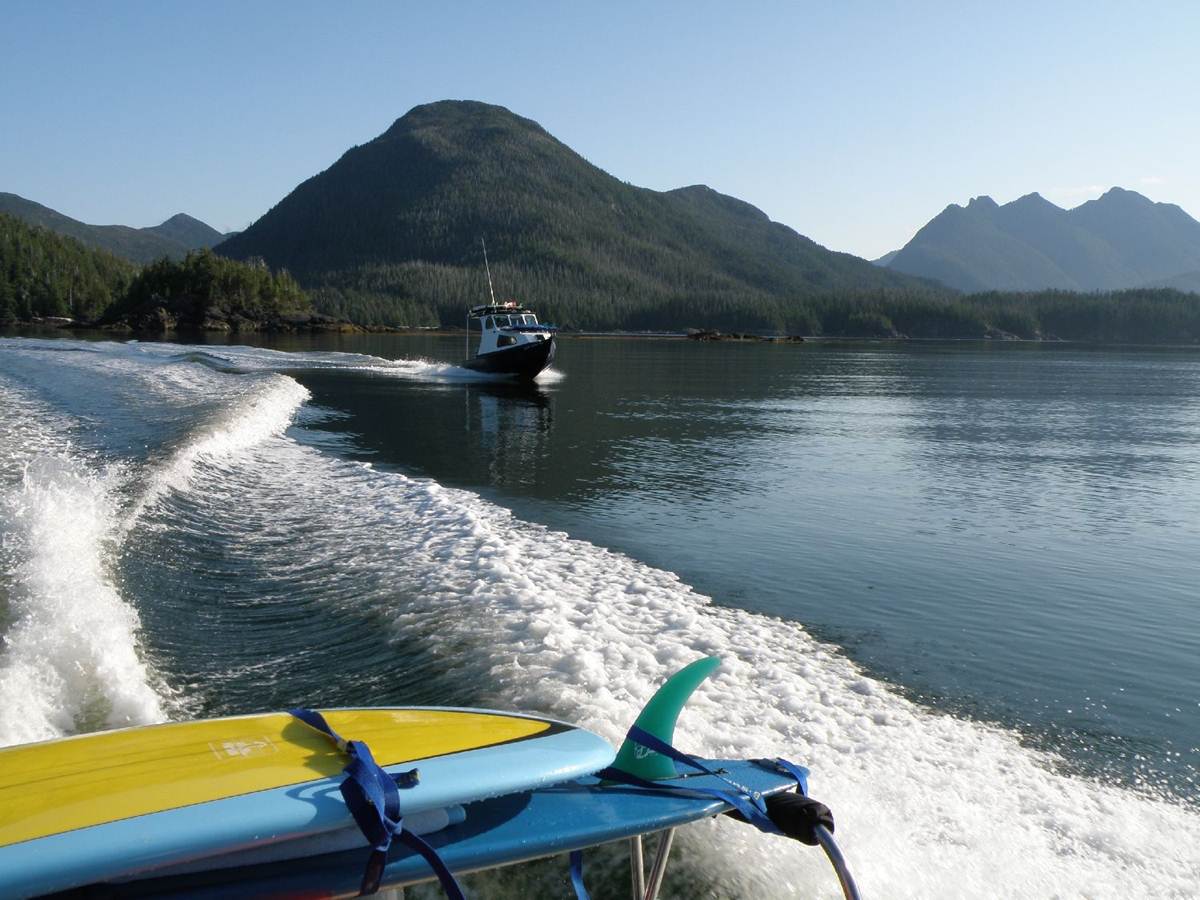
Photo
courtesy of Jeff Chamberlain.
Anybody else on them.. what's the feedback like?
I’ve had a few open-minded friends order some from various
shapers that have been working with me, and they’ve always
reported back mind blowing fun and surprise after they first use them.
A bunch of guys down in the Hollister Ranch have some, and in those
waves, they’re really taking these boards to places that are
starting to get noticed. But paipo and/or "prone surfing"
still remains a pretty small surfing niche, so the spread will be slow
I would expect. I surf often with longtime friend Sam George, and
he’s ridden them a bunch in various conditions and locales.
Here’s an email he sent me recently about his experiences on them:
To: Jeff Chamberlain
Subject: Fire in my Belly
When it comes to wave riding vehicles I've watched Jeff Chamberlain
surfing just a little bit ahead of the curve for over 40 years now.
Tri-fins in '72, longboards in '74, hybrids in '76; ten-foot plus
California paddle-in guns, Styrofoam/epoxy fun shapes, stand-up paddle
boards (well, giant single fins, really.) So when I saw Jeff's latest
application of sensible and farsighted surfboard design I was the last
person to snicker. If Jeff says that a 6'3", 31" wide bellyboard
delivers about 90% of every wave riding sensation we've spent the bulk
of our lives pursuing, and does so in virtually any size wave (adding,
completely dead-panning, that every wave ridden on your belly is way
overhead) and that following our vestigial Greenough obsession with
zero volume and a quarter-century of watching bodyboarders define the
prone attack it can be asserted that they've got it wrong all these
years and that the key to efficient belly riding is to stop dragging
your legs and get your whole body up onto the board...well then I'm
inclined to believe him. Especially after sharing a handful of sessions
with Jeff, me riding his back-up belly machine in classic California
point surf, rifling beach break and wedging reef peaks, finding myself
screaming down the line or in the tube, my cheek inches from the wave
face, the sensation of speed amplified by the intimate proximity to the
energy source, and pulling out at the end of each and every ride with
the biggest grin on my face and feeling like the little tow-headed kid
who lives in every surfer but who has been inexorably beaten down by
years of peer pressure, performance anxiety and fashion concerns.
Oh, and if you really want you can stand up on them.
Sam
at………..Spot X
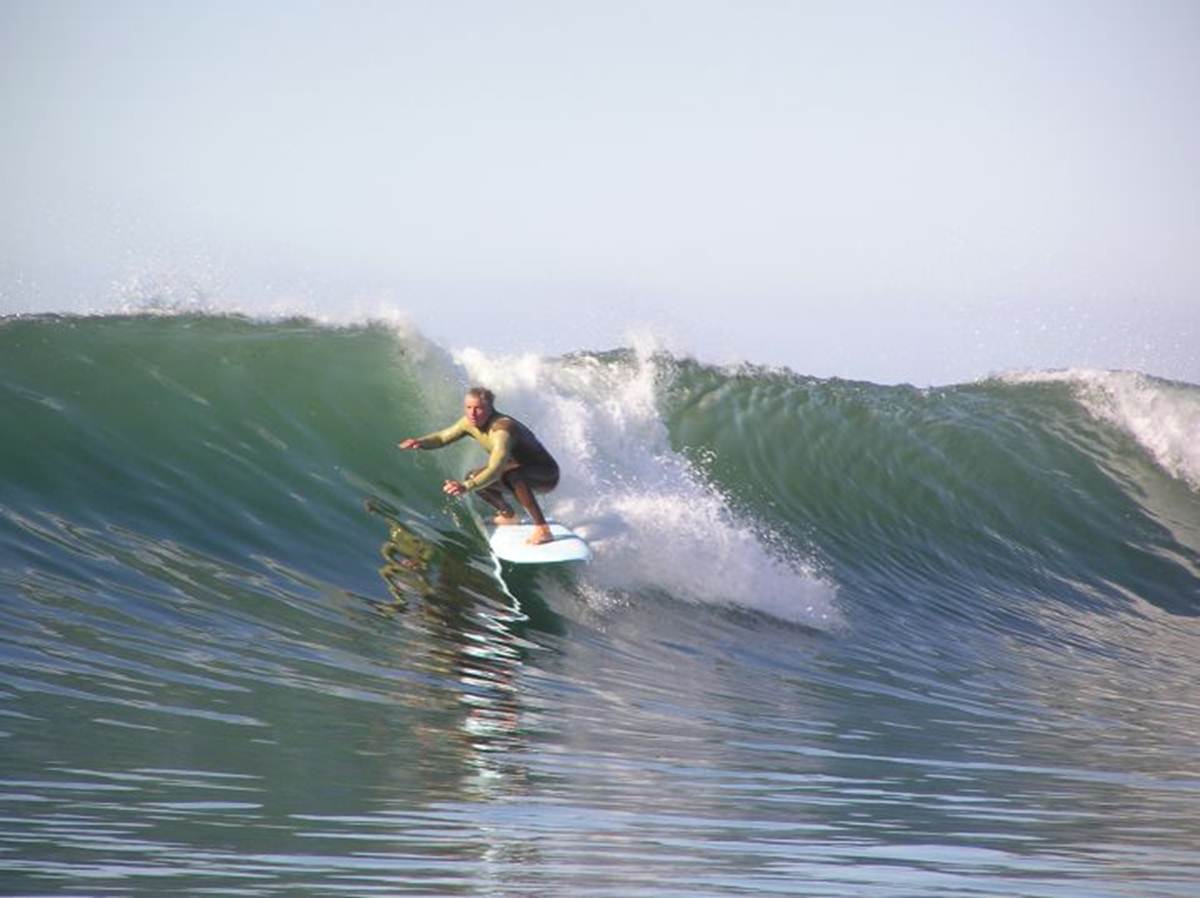
Photo
courtesy of Jeff Chamberlain.
Part
of the batch that Shane shaped up for my buddy Dr. Al and his
friends…
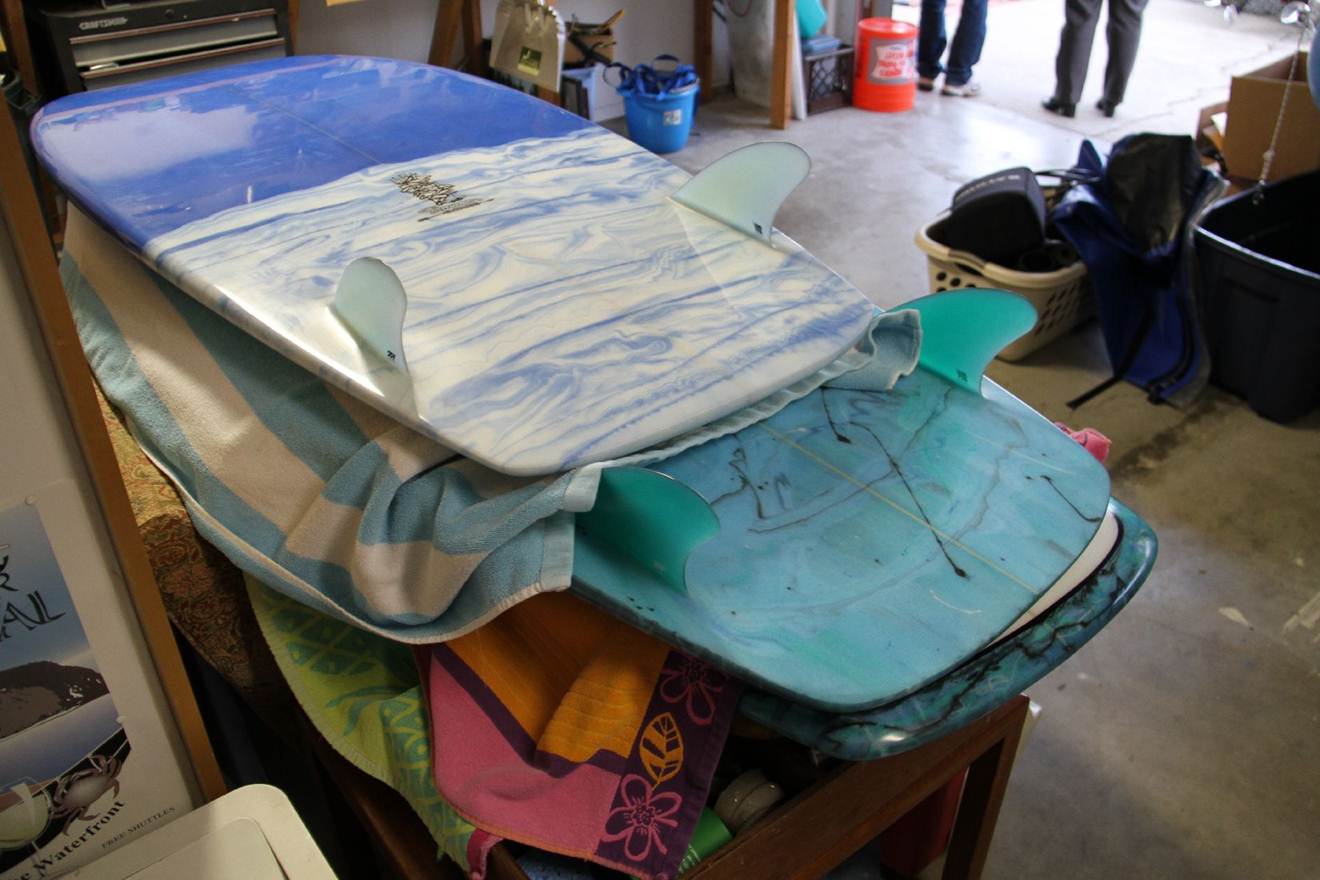
Photo
courtesy of Jeff Chamberlain.
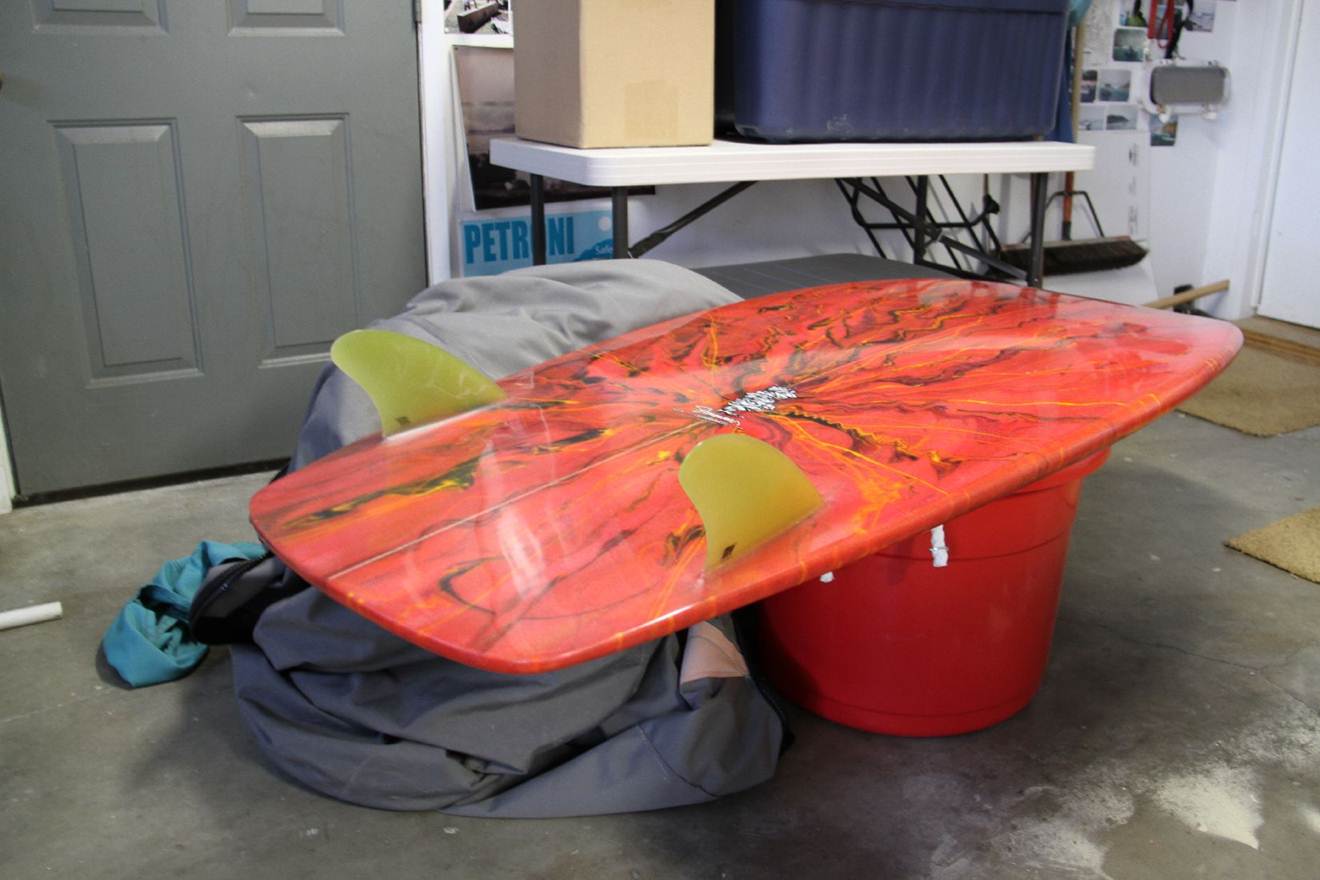
Photo
courtesy of Jeff Chamberlain.
7. What's next for you in
design and board making? Where do you want to go from here?
Well, dimension and template wise, I think I’m about 95percent "there." I think from here on out, it’ll be mostly
refinement and detail work, and of course, the always ongoing trail of
how to "best" ride these things. When I first started
riding paipo full time, the whole surfing part of it seemed pretty
straightforward. But I’ve come to realize that it’s
anything but, and with all the nuance and subtleties of this type of
wave riding, I’m just trying to improve my actual ability to surf
these things, and take them to new areas, or do some things
better……………. things like that.
It’s all been just a fantastical experience, and such a bitchen
way to sort of re-focus my surfing life.
John
Mellor with a self-shaped hoop fin, carbon fiber, KNIFE railed prone
machine…
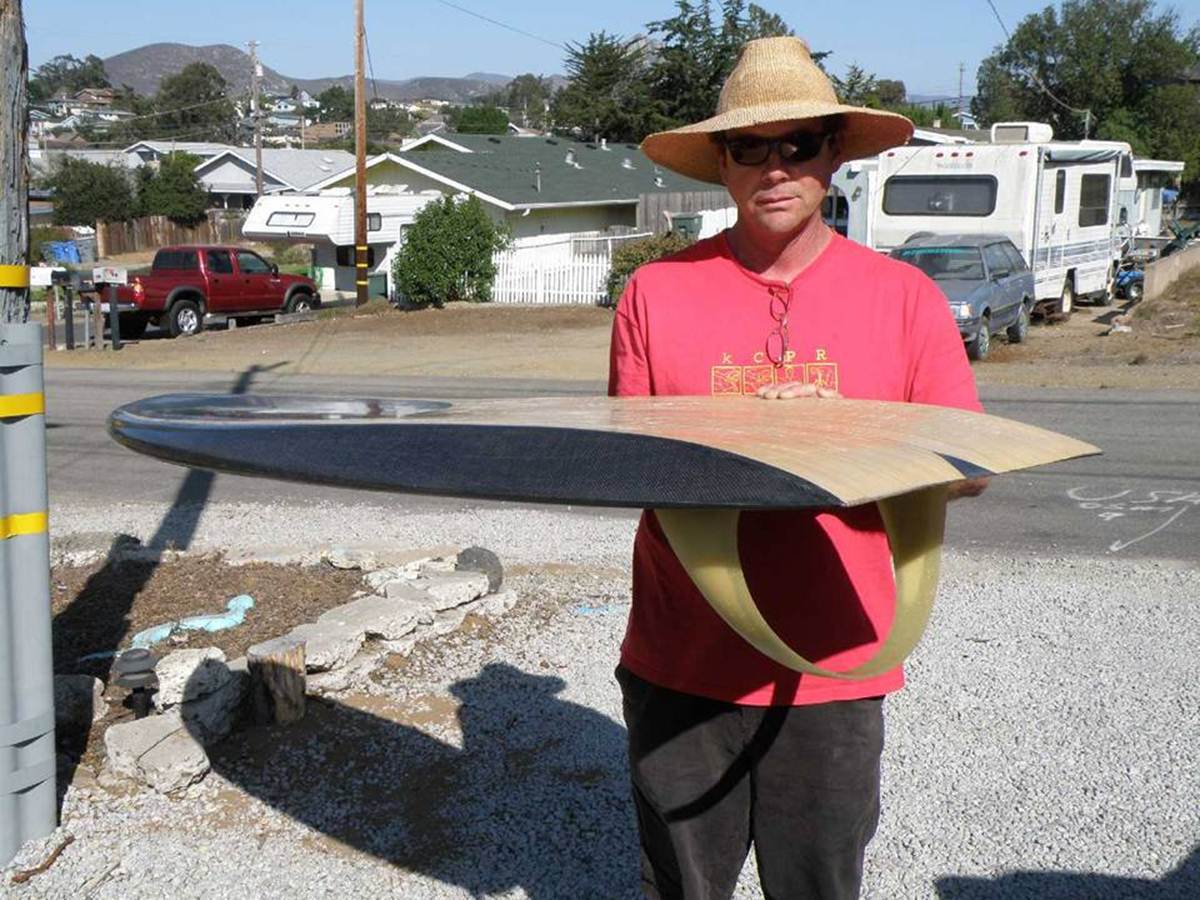
Photo
courtesy of Jeff Chamberlain.
An
early hoop fin board for myself.
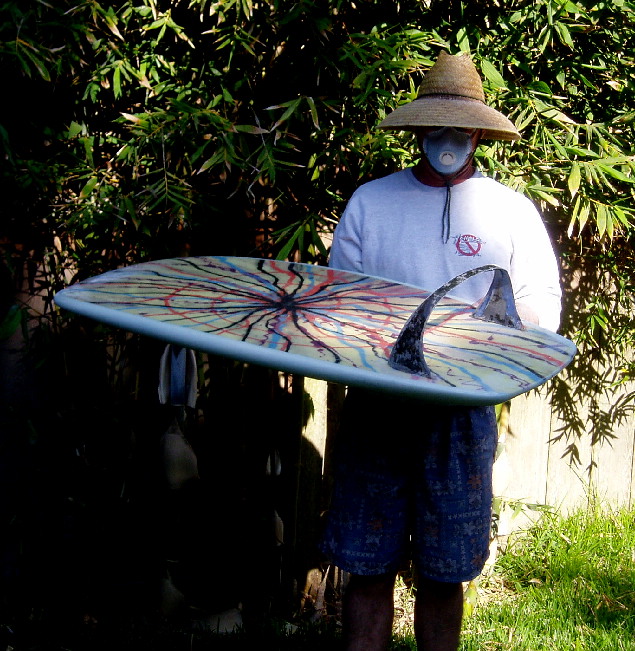
Photo
courtesy of Jeff Chamberlain.
John
reported that the fin took more effort to build than the entire board.
He researched the concept HEAVILY, leaning on some friends in Australia
that had been experimenting at full speed with this type of thing [see Note 2].
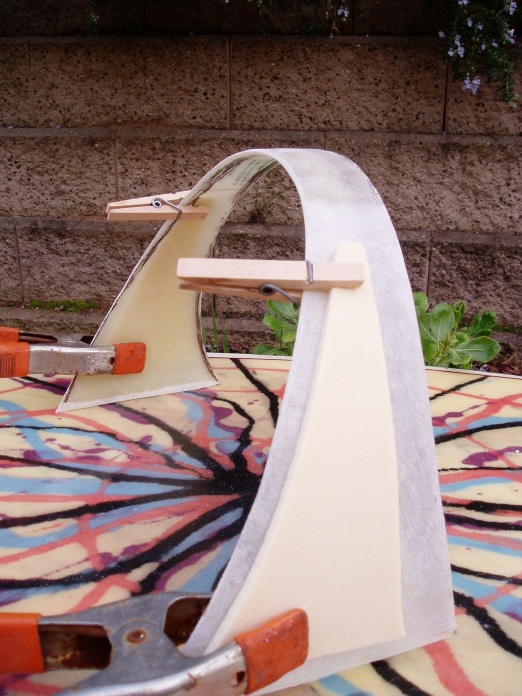
Photo
courtesy of Jeff Chamberlain.
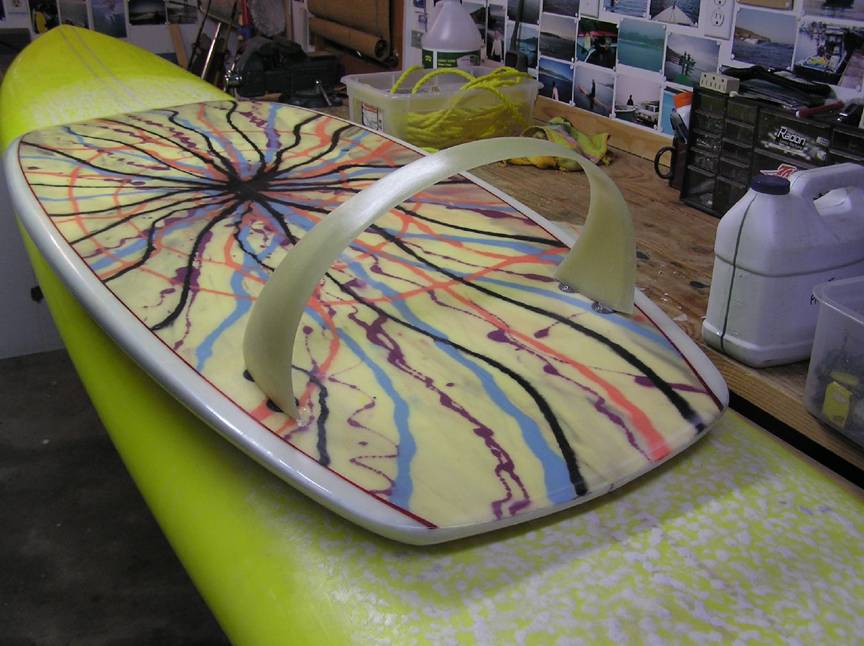 |
People would always ask, "…well, how does it work?" My response, “Well,
it doesn’t work any better than a
standard twin fin. But ……………. it
also doesn’t work any worse, so I guess that’s saying there
may be some validity to ‘em?’ This particular one was
sheared off after a high speed collision with a 3-inch deep sandbar,
a bit of a problem when the fin is 12 inches deep…. John crafted
up another one, god bless him, but in the end, they would only work in
"clear water" type applications, and so much of my surfing
is done in kelp environments, that it was a fun design foray but not a
daily driver type of keeper. |
Photo
courtesy of Jeff Chamberlain.
8. Any thoughts on the overall
state of the current paipo surf niche? And today's surfing culture and
direction in general?
Well,
it’s hard not to notice that we exist in a time right now
when there’s never been more varied surfcraft out and about in
the waves. I think everyone can agree on that. Body surfing has come
back into favor, handboards are now almost "standard," the
mat riding thing seems to be getting bigger and more accepted, and all
of this "new mentality" just seems to be getting better and
accepting. Paipo-wise, up here, in this county, there’s just not
that much going on on any kind of large, noticeable scale. Maybe more so
in Southern California or other big urban areas where there’s
more people. So all I ever really hear of the rest of "Paipo
World" is what I can glean off the web, or pick up through
snippets in articles. So I think it’s slow to expand which is as
you would expect. And I think guys are locked into whatever niche they
dig the most, wood boards, small twinnies, whatever, and that’s
fine with me. I’ve got several kneeboard friends who always
organize/participate in the big U.S. Champs every year. And
they’re
telling me that they’re getting so much feedback and stoke from
the emerging paipo nation, that starting this next year, they’re
going to be including a "paipo division" in the contest,
and that will be fantastic. Something like that could really combine
with a general expanding of our culture to start some sort of brush
fire that catches and spreads. I’d love to see that.
Addendum, December 2013: Catching up with Jeff Chamberlain and his evolving Mega Platter
Read and see some notes from Jeff on his continuing paipo experimentation adventure here. Narrative and pictures of the board on land and in the water.
Boats
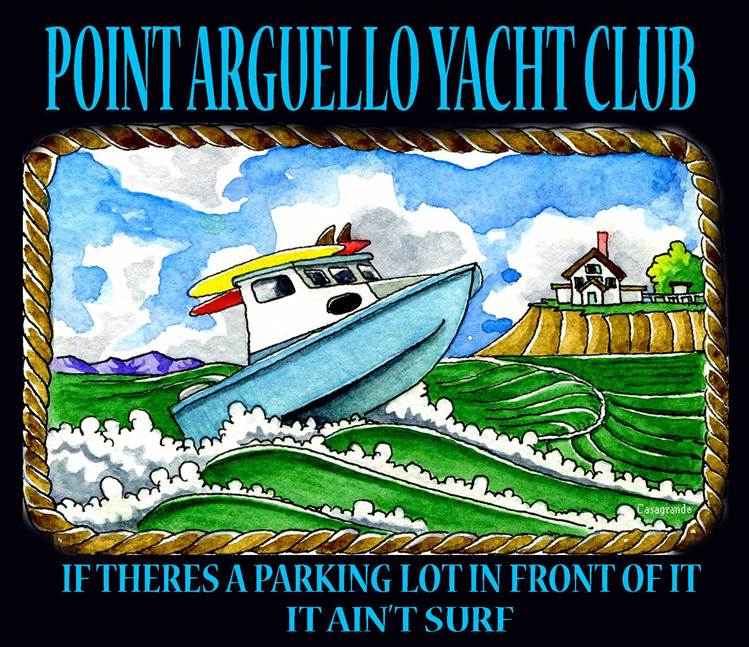
Photo
courtesy of Jeff Chamberlain.
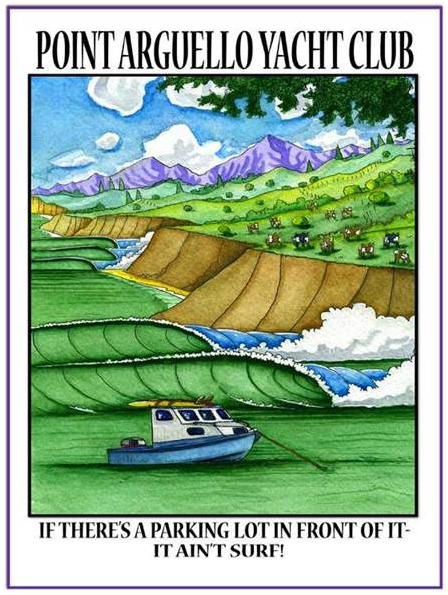
Photo
courtesy of Jeff Chamberlain.
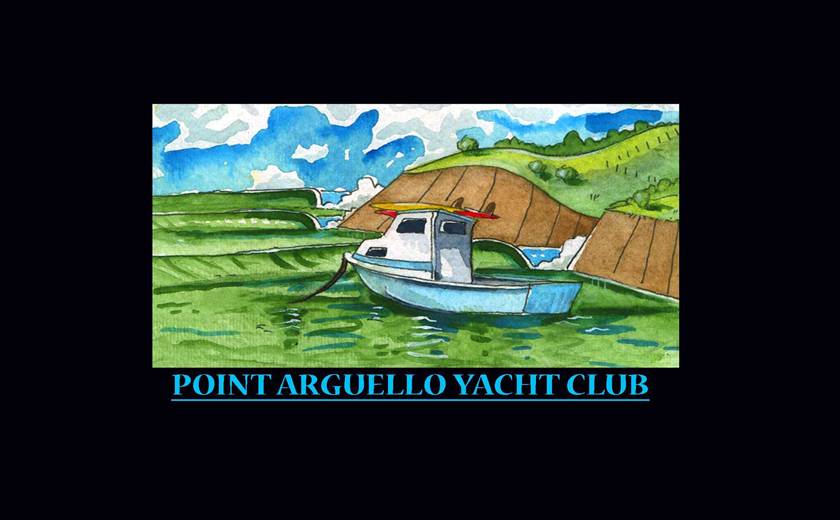
Photo
courtesy of Jeff Chamberlain.
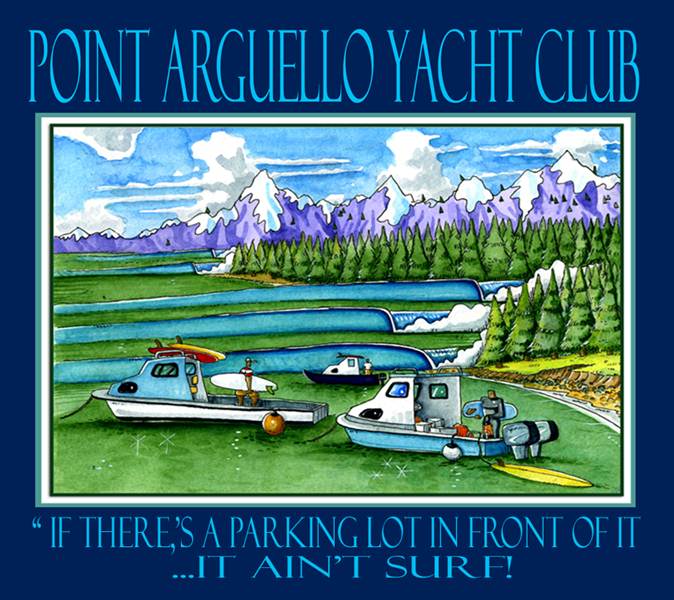
Photo
courtesy of Jeff Chamberlain.
Note 1. Some more of Jeff's experience with paipo boarding:
It's almost like this
paipo niche has self-divided into two camps: those that ride the much
smaller boards, and create for themselves what is in many ways a kind
of "bodysurfing experience," '... body in the wave, legs dangling,
totally in the pocket. And the "prone" guys who seem to be more
surfboard-oriented, whatever type of board that is (and it seems to be
way different for each guy)... More board-oriented, less body in the
water, surfboard principles coming into play.
Hard to paddle? No, very easy.
Although, after experimenting with lots of different ways to paddle,
what I've settled on is this: I kick with my arms straight out in front
of me, and at my fingertips is the board. I don't try to lay up on it
and paddle it like a regular board, though lord knows it probably has
more foam volume than say, your typical Channel Islands 6-2 thruster.
It's far more comfortable to just stretch out fully and kick
around in the fully elongated position. (I use Da Fin fins exclusively.)
If you watch any old George Greenough movies that show him paddling...
that's how he paddled those sub-surface spoons he was riding. And even
though my boards have way more float than those, it's still the best
way to get around the lineup, and I ride a lot of point breaks so I'm
used to long, extended paddles back out to the takeoff spot.
Ride Characteristics? What I
was looking for was to create the fastest board possible, a board that
caught waves easily, that planed over dead spots, and that had some
carry through. The small boards for me stopped almost instantly once
you came out of the pocket, much like a mat tends to do. That wasn't
working for me. I wanted to take these things beyond the shorebreak
into some real surf. There is so much flat area that a ton of
horsepower gets created and the boards have fantastical glide.
Wave Catching? With my smaller
boards, I found that the takeoffs were really more about positioning
yourself right under the lip for takeoff, with every takeoff being
quick and steep. With the bigger plan shapes, I can now paddle "in"
from outside a bit, and it functions far more like a traditional
surfboard.
Note 2. Surfoils from Swaylocks was one of these guys. See the Paipo Interview with Surfoils (Brett Curtis).
|
|





















































